Contemporary ART-HIST Final: Key Works
1/53
There's no tags or description
Looks like no tags are added yet.
Name | Mastery | Learn | Test | Matching | Spaced |
|---|
No study sessions yet.
54 Terms
![<p><strong>Julio Le Parc</strong> [Argentina]</p>](https://knowt-user-attachments.s3.amazonaws.com/78ccb4a4-6236-4dfc-a0fd-fab04f2b362b.png)
Julio Le Parc [Argentina]
Title: Continuous light mobile
Time: 1960s.
Known for:
System of spotlights used to direct light across the surfaces of the scattered hanging discs.
The constantly shifting light and reflections symbolize the fluidity of perception and how reality is never fixed. Art, like life, is in perpetual motion.

![<p>Lygia <strong>Clark</strong> [Brazil]</p>](https://knowt-user-attachments.s3.amazonaws.com/a920432f-f7d5-460c-b7d4-44d45c3122d9.png)
Lygia Clark [Brazil]
Title: Bicho
Time: 1960.
Known for:
Interactive metal sculptures meant to be manipulated by the viewer.
Challenged the idea of art as static or untouchable
Symbolized a living, evolving form — art as a dialogue between object and viewer, not a finished product.
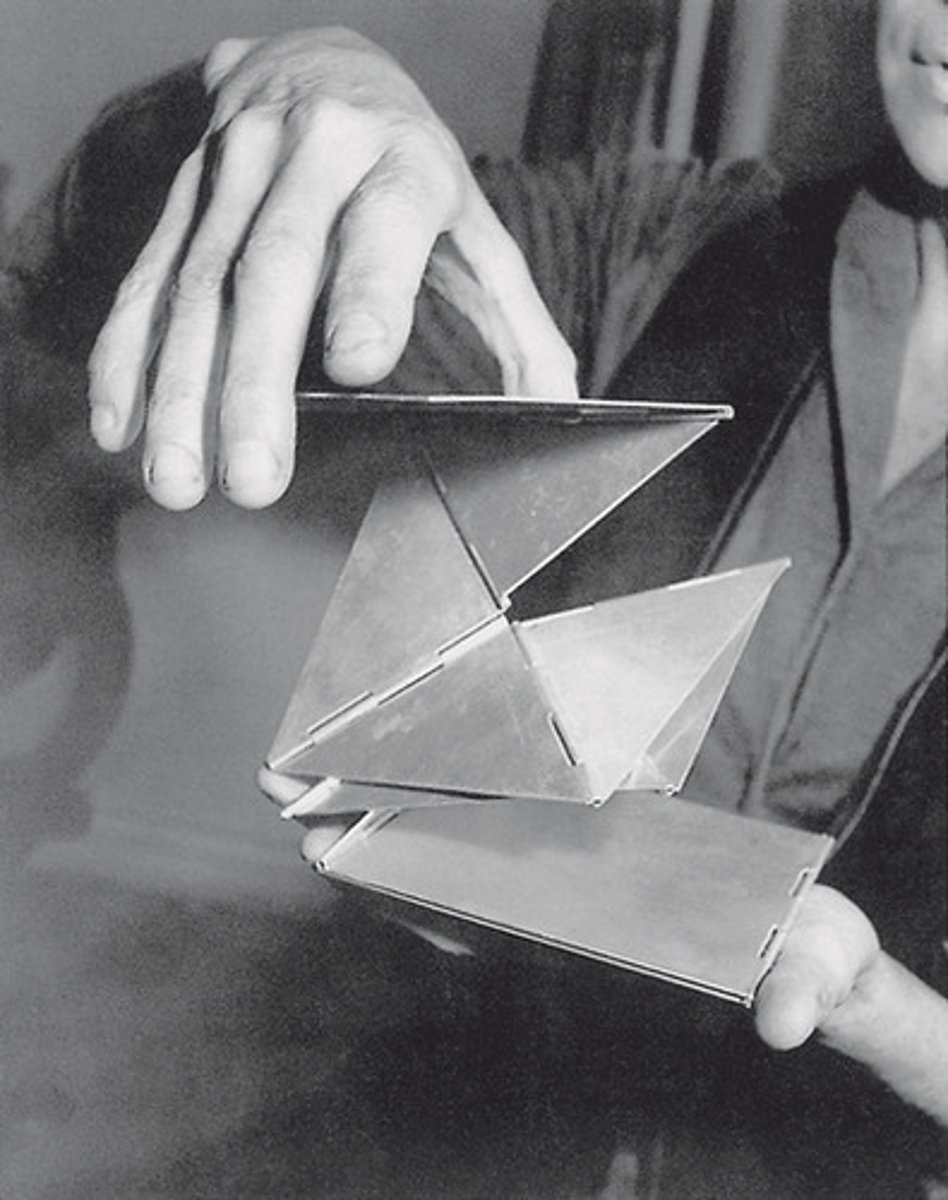
![<p><strong>Hélio</strong> Oiticia [Brazil]</p>](https://knowt-user-attachments.s3.amazonaws.com/e2ac85df-4c80-414e-a8c2-a18f471d8f40.png)
Hélio Oiticia [Brazil]
Title: Parangolé
Time: 1960s.
Known for:
preoccupied with the restraints that are imposed in Brazilian Society
wearable sculpture
Aim to Liberate the body
Took inspiration from favelas
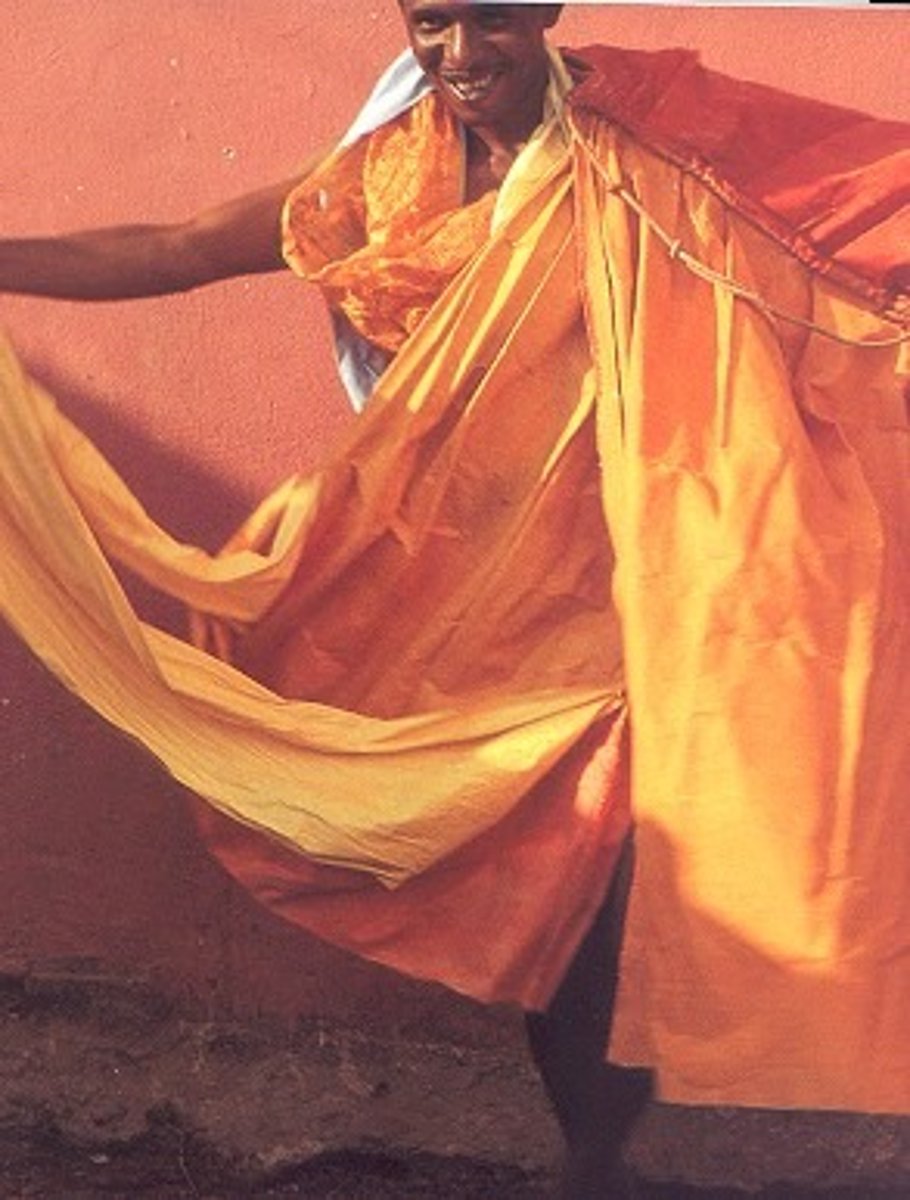
![<p><strong>Cildo</strong> Miereles [Brazil]</p>](https://knowt-user-attachments.s3.amazonaws.com/21c719d3-0a2a-4830-b327-5d2763f3326c.png)
Cildo Miereles [Brazil]
Title: Coca-Cola Project
Time: 1970s.
Known for:
A form of conceptual and political art that critiqued consumerism and authoritarianism during Brazil's military dictatorship.
Subversive messages on consumer goods
Critiques capitalism and ideology.

![<p>Doris <strong>Sal-cedo</strong> [Colombia]</p>](https://knowt-user-attachments.s3.amazonaws.com/673801a6-1da3-4a0a-8f9c-ef635158f54b.png)
Doris Sal-cedo [Colombia]
Title: Untitled (Armoire)
Time: 1990s.
Known for:
Powerful sculptural installations addressing violence, loss, and trauma from Colombia’s civil conflict.
Memorializes victims of civil unrest through poetic, haunting sculpture.
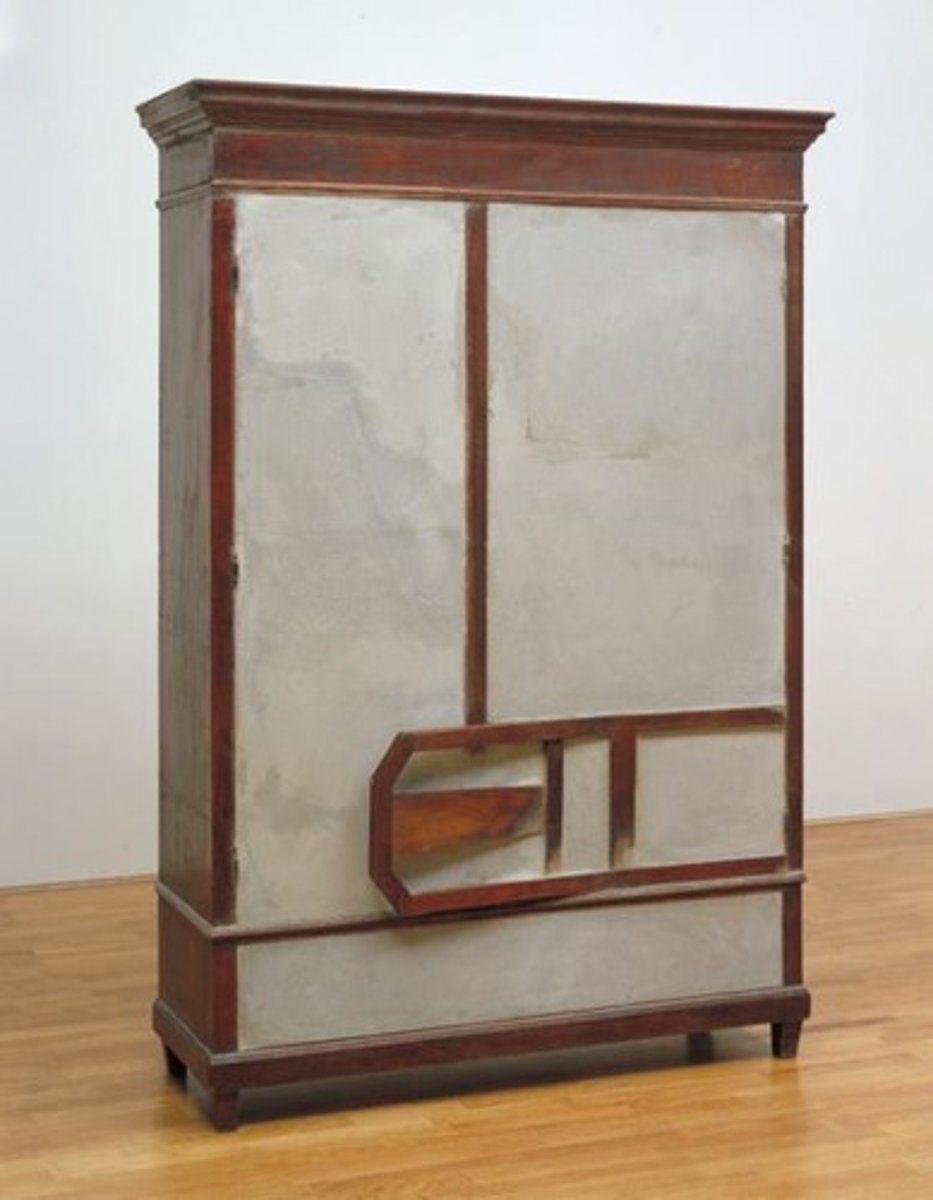
![<p>Ilya <strong>Kabakov</strong> [Soviet Union]</p>](https://knowt-user-attachments.s3.amazonaws.com/aec6ee93-8949-427b-8d9e-4a4d615991de.png)
Ilya Kabakov [Soviet Union]
Title: The Man Who Flew into Space from His Apartment
Time: 1980s.
Known for:
Fictional character narratives
Escape fantasies in communal spaces.
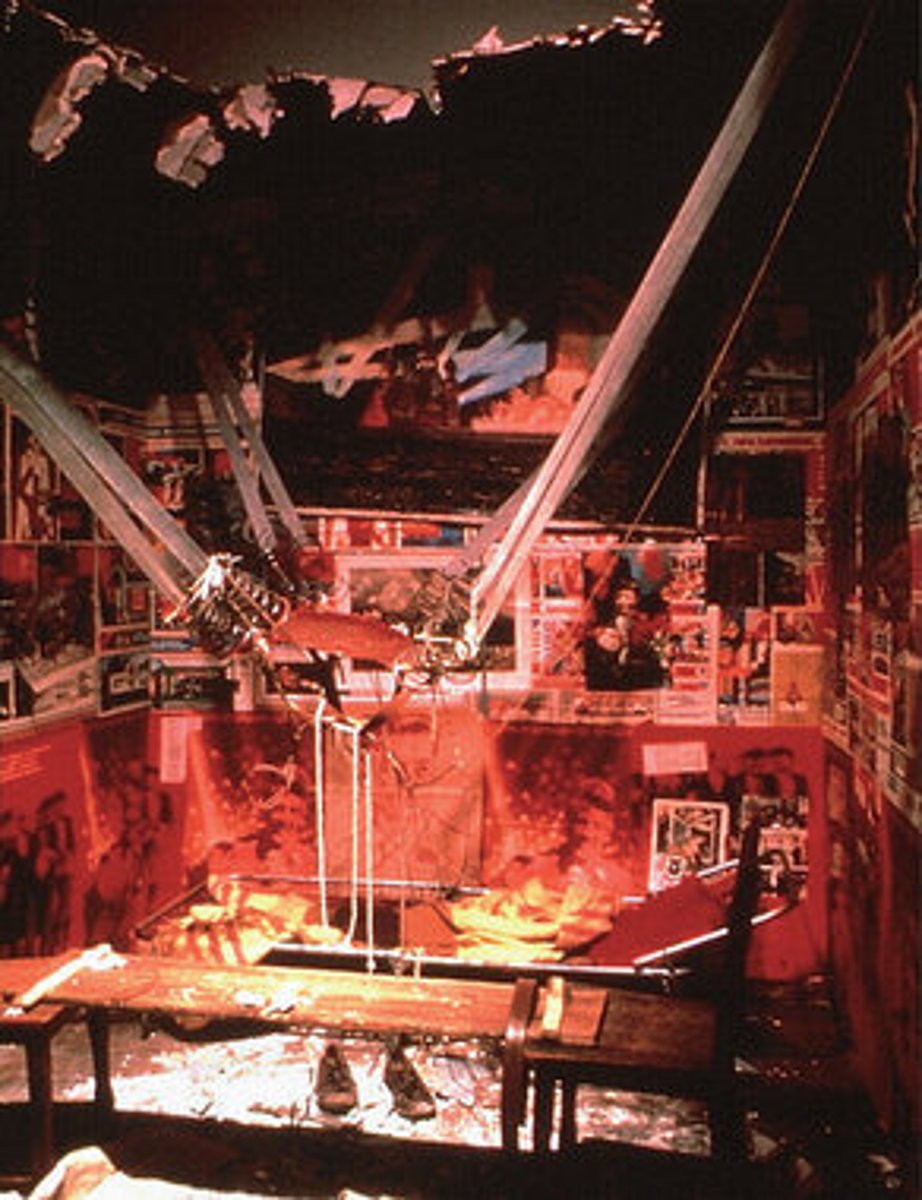
![<p>Vitaly <strong>Komar</strong> and Aleksandr <strong>Melamid</strong> [Soviet Union]</p>](https://knowt-user-attachments.s3.amazonaws.com/58a09538-8d96-470c-b7cc-27de997cd2ab.png)
Vitaly Komar and Aleksandr Melamid [Soviet Union]
Title: The Origin of Socialist Realism
Time: 1980s.
Known for:
Parody socialist realism
Critique propaganda through ambiguity.

![<p><strong>Marina</strong> Abramovic [Yugoslavia]</p>](https://knowt-user-attachments.s3.amazonaws.com/1c8b9410-cdd6-4795-9f1b-8288adb75166.png)
Marina Abramovic [Yugoslavia]
Title: Rhythm 5
Time: 1970s.
Known for:
lit a burning five-pointed star made of wood shavings and lay inside it, losing consciousness from smoke inhalation before the audience intervened.
Performance testing bodily limits
Symbolized personal sacrifice, ideological critique, and testing physical/mental boundaries.

![<p><strong>Sandor</strong> Pinczehelyi [Hungary]</p>](https://knowt-user-attachments.s3.amazonaws.com/2b85e22c-f6d5-47f7-8bb7-7bdfc1d8bd65.png)
Sandor Pinczehelyi [Hungary]
Title: Hammer and Sickle
Time: 1970s.
Known for:
Critiques political ideologies and identity via symbols of communism (hammer & sickle).
Known for exploring themes of political power, social change, and revolutionary discourse.

![<p><strong>Ion</strong> Grigorescu [Romania]</p>](https://knowt-user-attachments.s3.amazonaws.com/f053e4f6-a5a3-4c80-a360-2219f40b21a9.png)
Ion Grigorescu [Romania]
Title: Dialogue with Comrade Ceausescu
Time: 1970s.
Known for:
A performance and video art piece where Grigorescu engaged in a one-sided "dialogue" with Nicolae Ceaușescu, the authoritarian leader of Romania.
Used self-representation in a surreal, symbolic manner to highlight the oppressive atmosphere in Romania under Ceaușescu’s rule.
Experimental film/dialogue with Ceausescu under censorship.
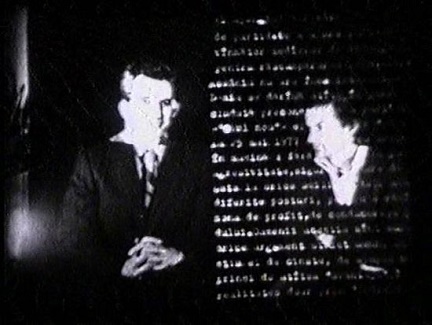
![<p><strong>Mladen</strong> Stilinovic [Yugoslavia]</p>](https://knowt-user-attachments.s3.amazonaws.com/70fe4a18-bef7-4875-88d6-80ecab9dd95c.png)
Mladen Stilinovic [Yugoslavia]
Title: An Attack on My Art Is an Attack on Socialism and Progress
Time: 1970s.
Known for:
Satirical use of socialist language
The work was a direct response to political repression and censorship, positioning the artist’s work as a form of resistance against any ideological or state-sponsored attack on creativity.

![<p><strong>New Collectivism </strong>[Yugoslavia]</p>](https://knowt-user-attachments.s3.amazonaws.com/94bf5e6a-5c8b-43f9-8578-b68953ff2c7c.jpg)
New Collectivism [Yugoslavia]
Title: Poster for the Day of Youth in Yugoslavia
Time: 1980s.
Known for:
A critical and ironic artwork that used the visual language of official propaganda to subvert and critique the political regime of Yugoslavia.
The work reflected dissent against the state's control over culture and its use of art for ideological indoctrination.
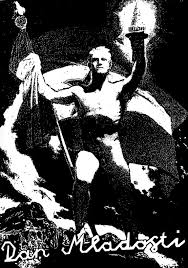
![<p>Huang <strong>Yongping</strong> [China]</p>](https://knowt-user-attachments.s3.amazonaws.com/f92f643d-0183-4231-8245-48f553338ac3.png)
Huang Yongping [China]
Title: A History of Chinese Painting and A Concise History of Modern Painting Washed in a Washing Machine for Two Minutes
Time: 1980s.
Known for:
East-West fusion; erased art histories via literal washing.
piece questions how history, culture, and identity are washed away or transformed in the face of political change and globalization.
often used unconventional materials and methods to provoke thought about the intersection of art, history, and societal development.

![<p>Xiao <strong>Lu</strong> <strong>and</strong> Tang <strong>Song</strong> [China]</p>](https://knowt-user-attachments.s3.amazonaws.com/fa7b0eb5-d7e9-4e9e-b521-47215b623376.png)
Xiao Lu and Tang Song [China]
Title: Dialogue
Time: 1980s.
Known for:
Xiao Lu fired two gunshots at her own installation — a phone booth-like glass structure with two telephones inside — in a symbolic act (Breaking Silence & Repression)
The act itself became the “dialogue” — a direct, shocking confrontation with a system that suppressed open conversation.
possibly foreshadowed Tiananmen Square protests later that year.
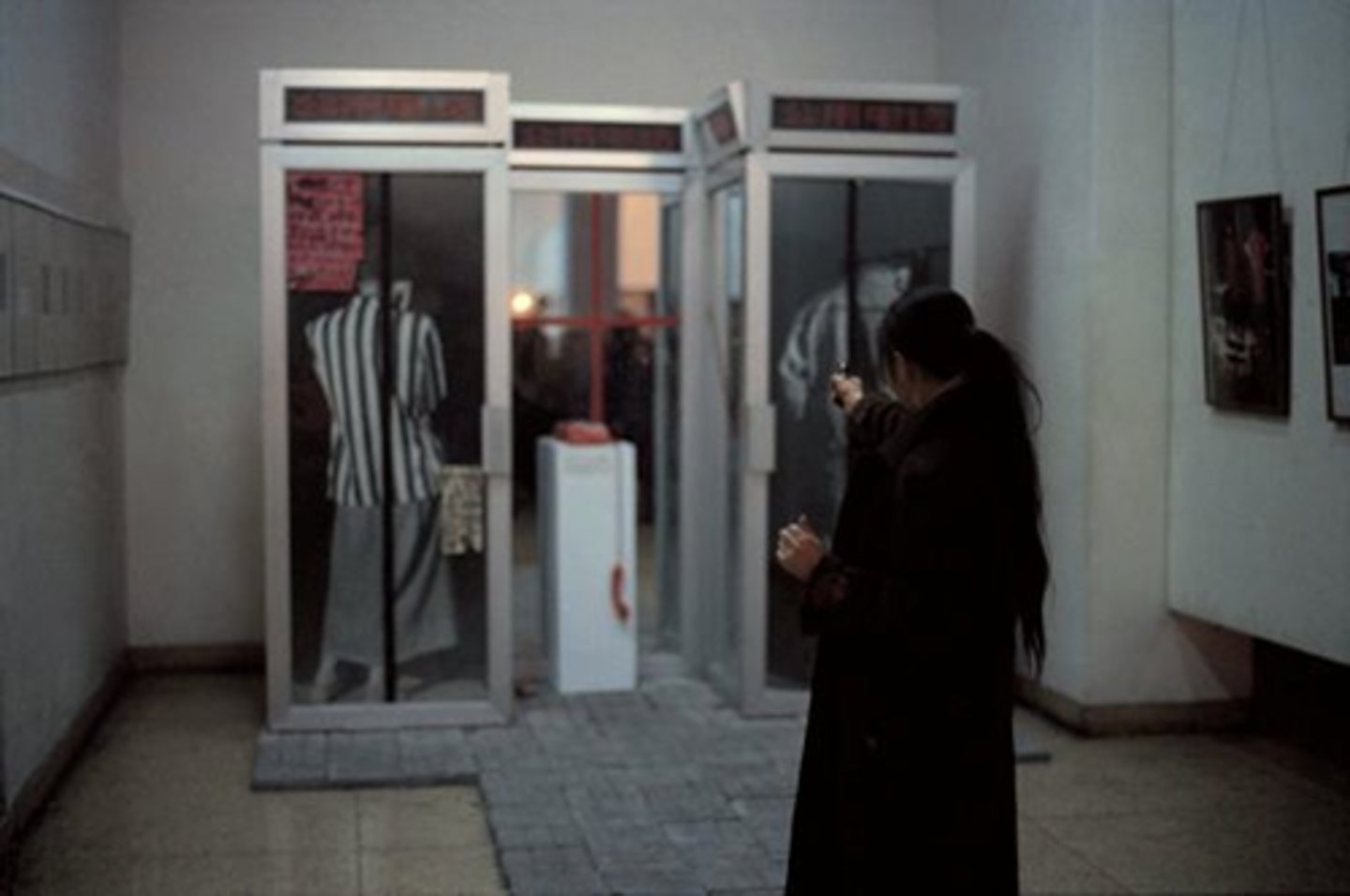
![<p><strong>Wang Guangyi</strong> [China]</p>](https://knowt-user-attachments.s3.amazonaws.com/675c3804-df80-40fe-8619-680e4649ede4.png)
Wang Guangyi [China]
Title: Great Criticism - Coca Cola
Time: 1990s.
Known for:
"Political Pop" art
Merges socialist iconography with capitalist branding (Coca-Cola).
Known for addressing political and social issues through conceptual and installation art,
Reflects growing concerns over China's rapid modernization and the complex cultural exchanges occurring during this time.

![<p>W. <strong>Jingsong</strong> [China]</p>](https://knowt-user-attachments.s3.amazonaws.com/c01068b4-dea3-436d-907b-54d14b37e27d.png)
W. Jingsong [China]
Title: Taking a Picture in front of Tiananmen Square
Time: 1990s.
Known for:
"Cynical Realism"
Critiques Mao’s legacy via obscured portrait in ironic realism.
A commentary on the gap between public political narrative and private expression, questioning how memory and history are shaped by authoritarian control.
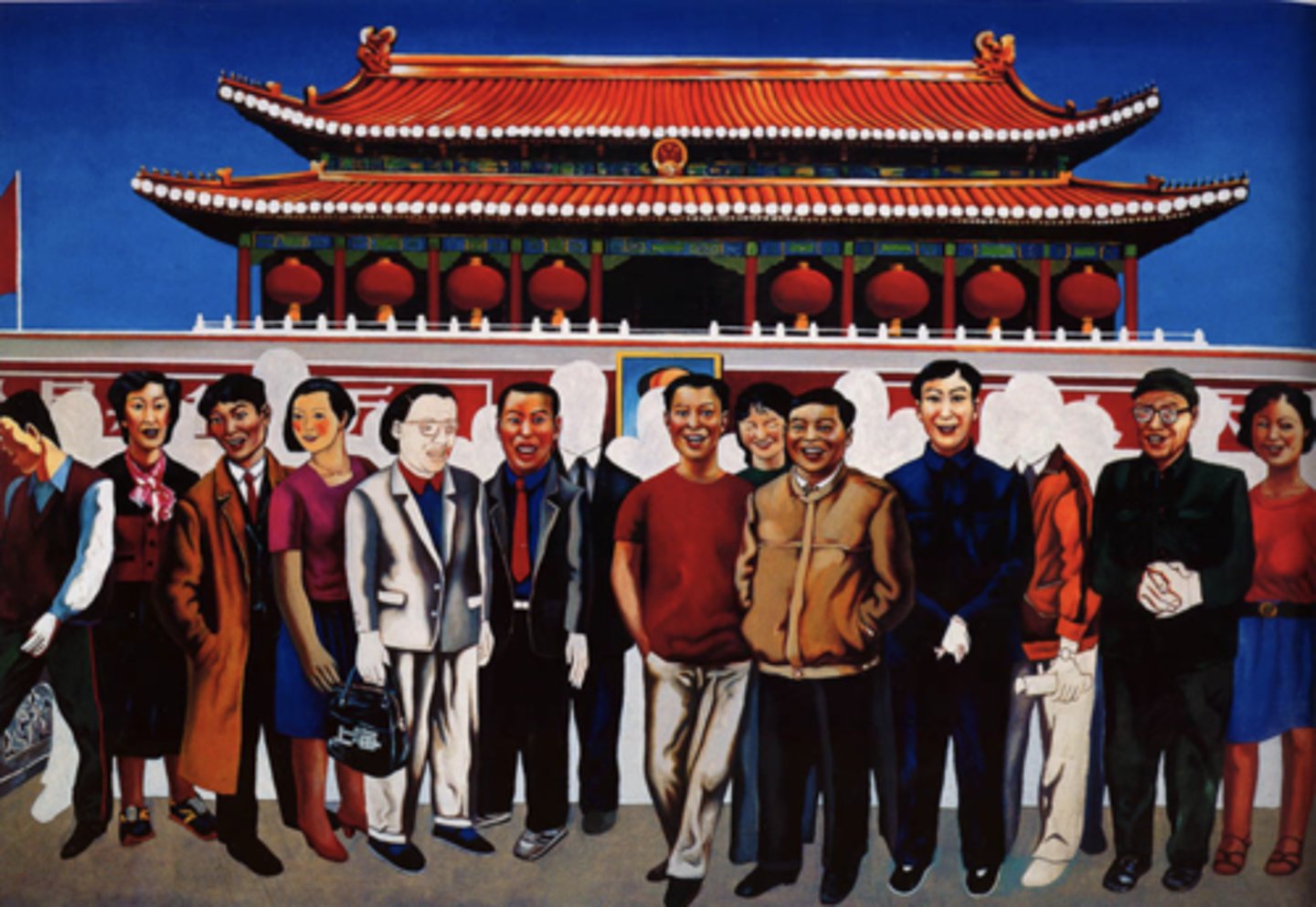
![<p>Yayoi <strong>Ku-sama</strong> [Japan]</p>](https://knowt-user-attachments.s3.amazonaws.com/9632ae2e-fee0-48e9-9f83-f07a48cca301.png)
Yayoi Ku-sama [Japan]
Title: Infinity Mirror Room - Love Forever
Time: 1960s.
Known for:
Minimalist tendencies as an artist
explore themes of infinity, repetition, and self-obliteration, reflecting her personal struggles with mental health and obsessive patterns.
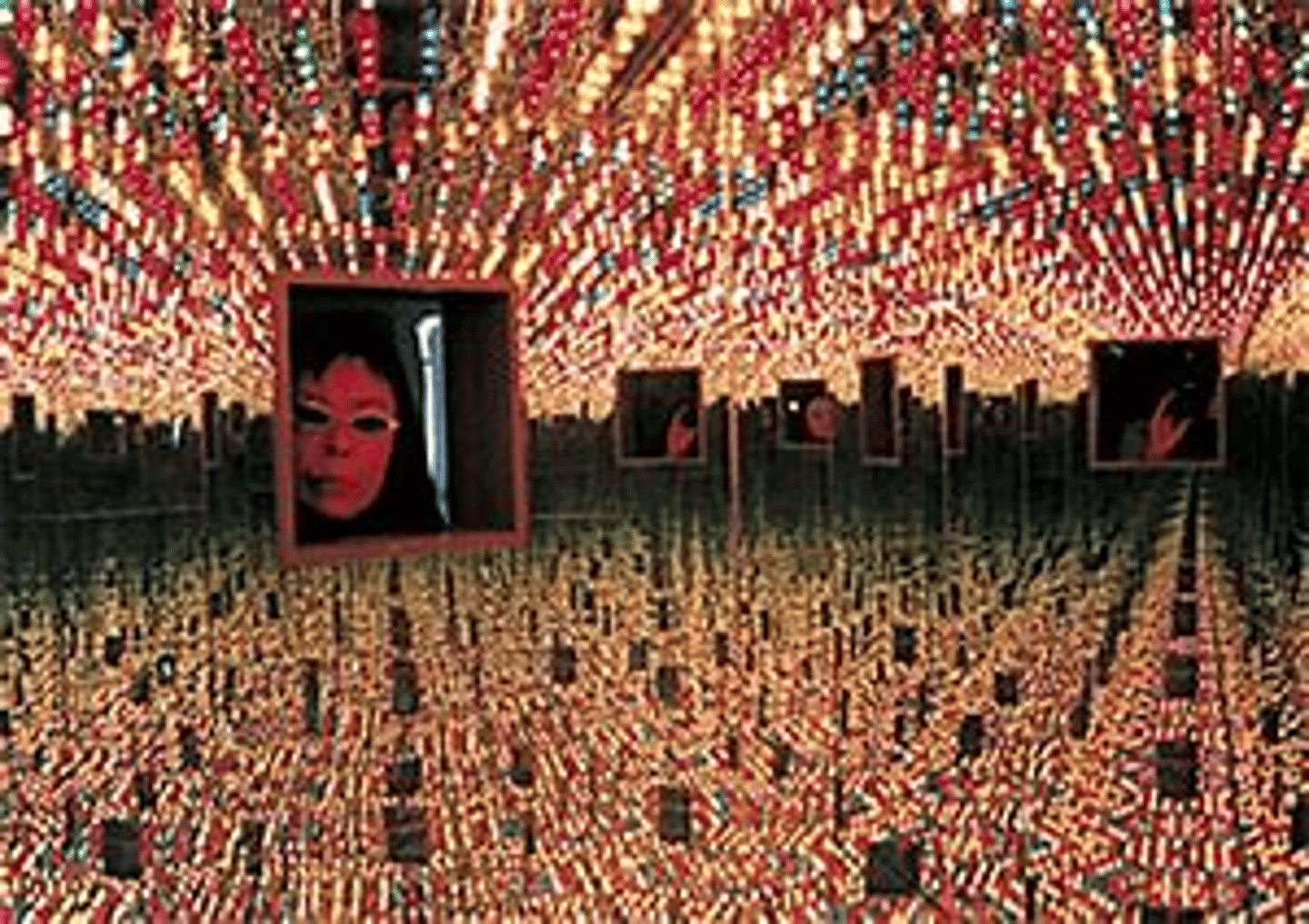
![<p>Yasumasa <strong>Mori-mura</strong> [Japan]</p>](https://knowt-user-attachments.s3.amazonaws.com/6e599c14-b4e9-4de6-a429-17cdb3b8bc44.png)
Yasumasa Mori-mura [Japan]
Title: Daughter of Art History (Theater B)
Time: 1990.
Known for:
Reinterprets classical Western paintings, specifically examining the role of women in art history and challenging the dominant narratives in art.
Critique of cultural identity, especially the role of Japanese artists in global art history and how non-Western artists are represented (or excluded).
Reenacts Western masterpieces; explores race and gender.
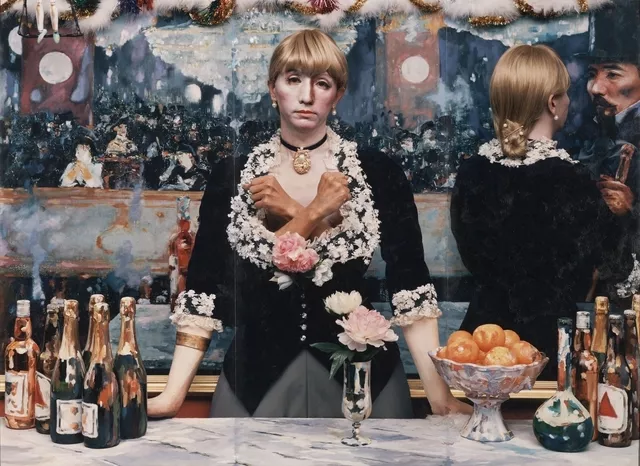
![<p>Takashi <strong>Murakami</strong> [Japan]</p>](https://knowt-user-attachments.s3.amazonaws.com/316a4925-29ae-4a3f-9753-47fed7fe1daa.png)
Takashi Murakami [Japan]
Title: Miss ko2 (Project ko2)
Time: 1990s.
Known for:
The piece critiques the intersection of humanity and technology, particularly in the context of globalization and post-humanism, where digital identities begin to shape our understanding of self.
Known for his Superflat art style, which merges high and low culture (such as commercial art and fine art),
Reflects on the influence of consumer culture on identity formation.
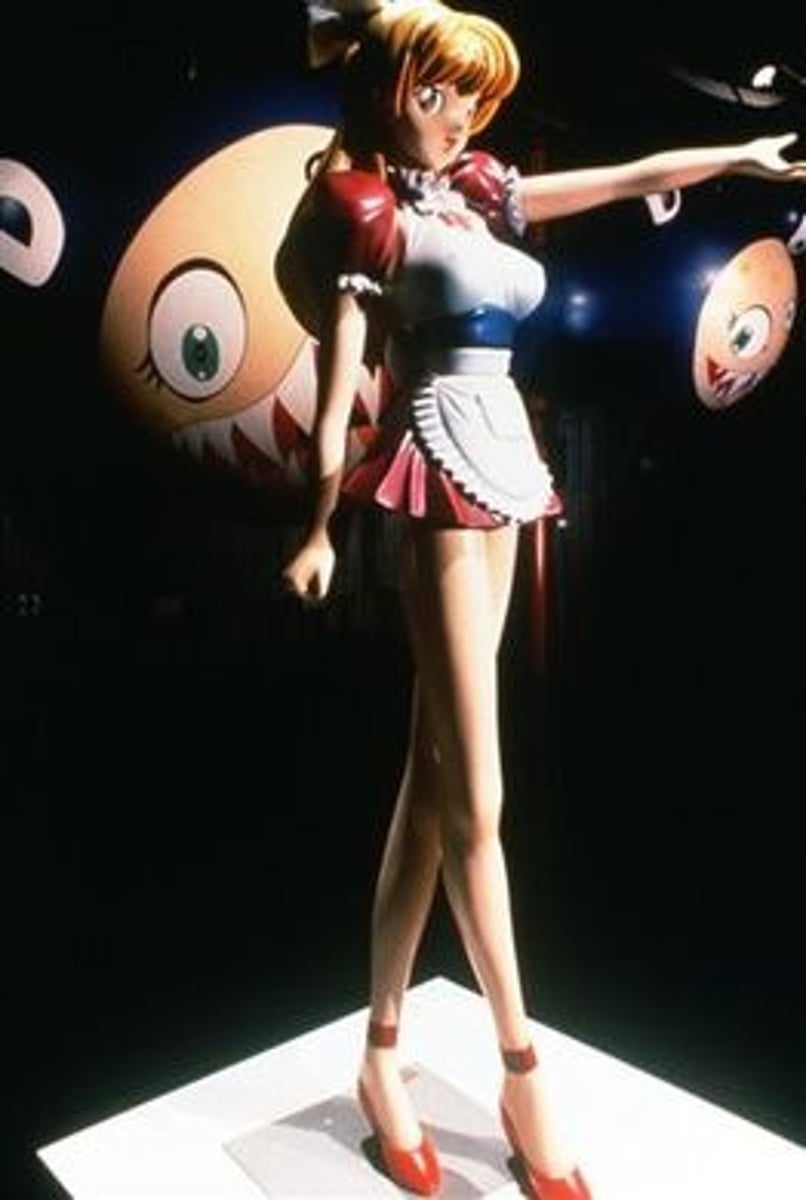
![<p><strong>Do-Ho Suh</strong> [South Korea]</p>](https://knowt-user-attachments.s3.amazonaws.com/c7d051b2-71ed-4932-83dc-e778f909a611.png)
Do-Ho Suh [South Korea]
Title: Floor
Time: 2000.
Known for:
The work symbolizes home and displacement, often using his own experiences as an immigrant to explore the fragility and permeability of personal and cultural identity.
Known for transforming everyday environments into intimate, emotionally charged experiences, invites viewers to reflect on the relationship between architecture and the self.
Explores identity and collectivity via delicate installations (plexiglass).

![<p>Subodh <strong>Gupta</strong> [India]</p>](https://knowt-user-attachments.s3.amazonaws.com/13acc645-edad-4085-8e93-99ed31953de4.png)
Subodh Gupta [India]
Title: Line of Control
Time: 2008.
Known for:
The "Damien Hirst of India"
Monumental forms using everyday utensils
Symbolizing the divisions and separations created by the conflict and the violence that arises from it.
Reflects ongoing conflict on the India-Pakistan border (nuclear explosion).
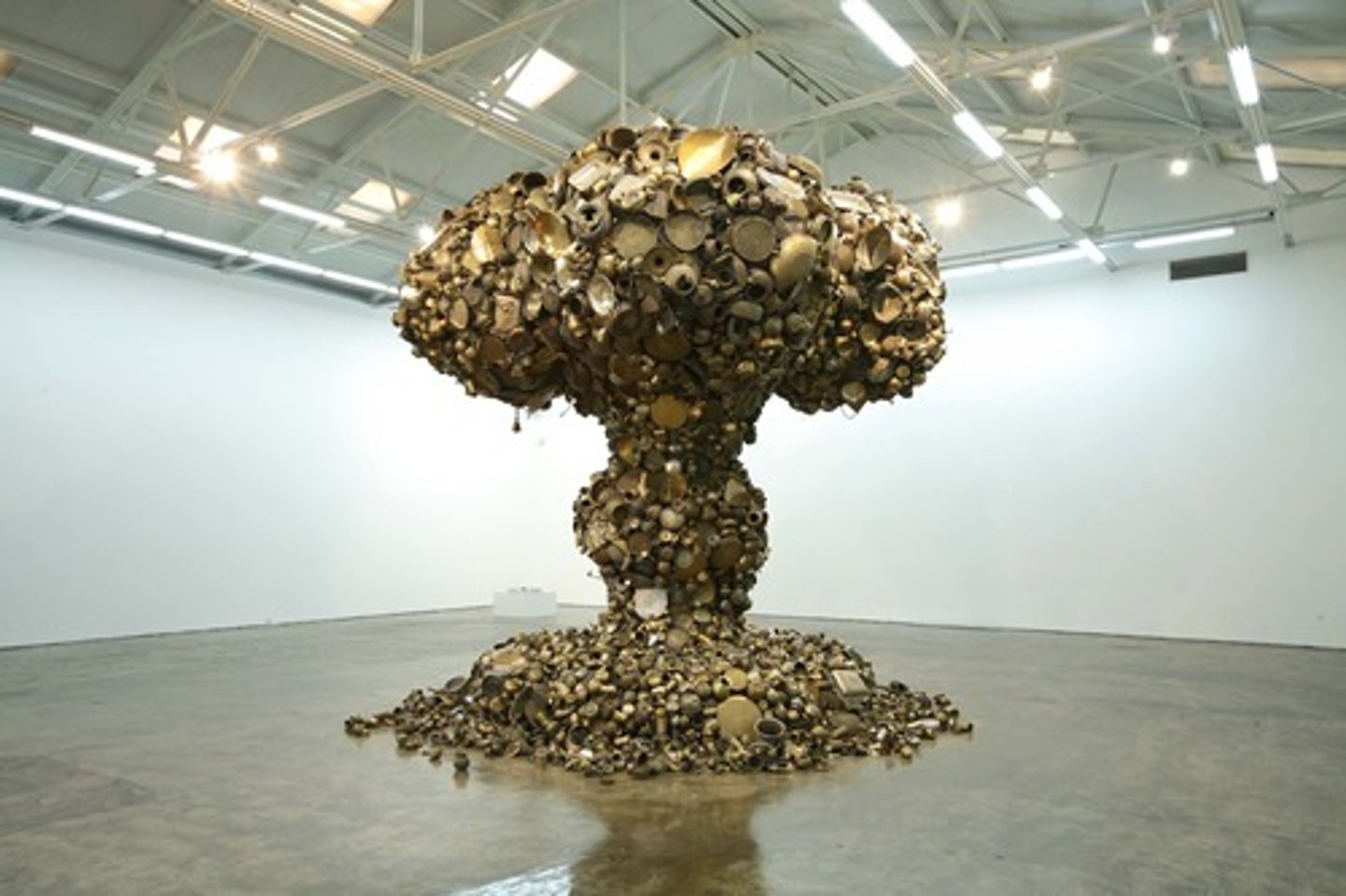
![<p>Bodys Isek <strong>Kin-gel-ez</strong> [Congo]</p>](https://knowt-user-attachments.s3.amazonaws.com/8c0f7b49-cf16-4f93-ad81-5c16c60a9c21.png)
Bodys Isek Kin-gel-ez [Congo]
Title: Kimbeville
Time: 1990s.
Known for:
Fantastical city models of a utopian vision of African modernity
Invites viewers to consider the potential of bringing about such cities into being

![<p>Yinka <strong>Shon-i-bare</strong> [Nigerian-British]</p>](https://knowt-user-attachments.s3.amazonaws.com/66330140-b76a-448d-a68f-250e6e09f18c.png)
Yinka Shon-i-bare [Nigerian-British]
Title: Gallantry and Criminal Conversation
Time: 2002.
Known for:
The piece features mannequins dressed in 18th-century-style costumes, using African fabric, blending British colonial history with African cultural symbols. This juxtaposition reflects the complexity of post-colonial identity.
The title refers to the legal term for adultery in 18th-century Britain, suggesting the moral contradictions of colonialism
Uses Batik - \"A textile-based in a dyeing technique which utilizes wax Wax resistant dyeing
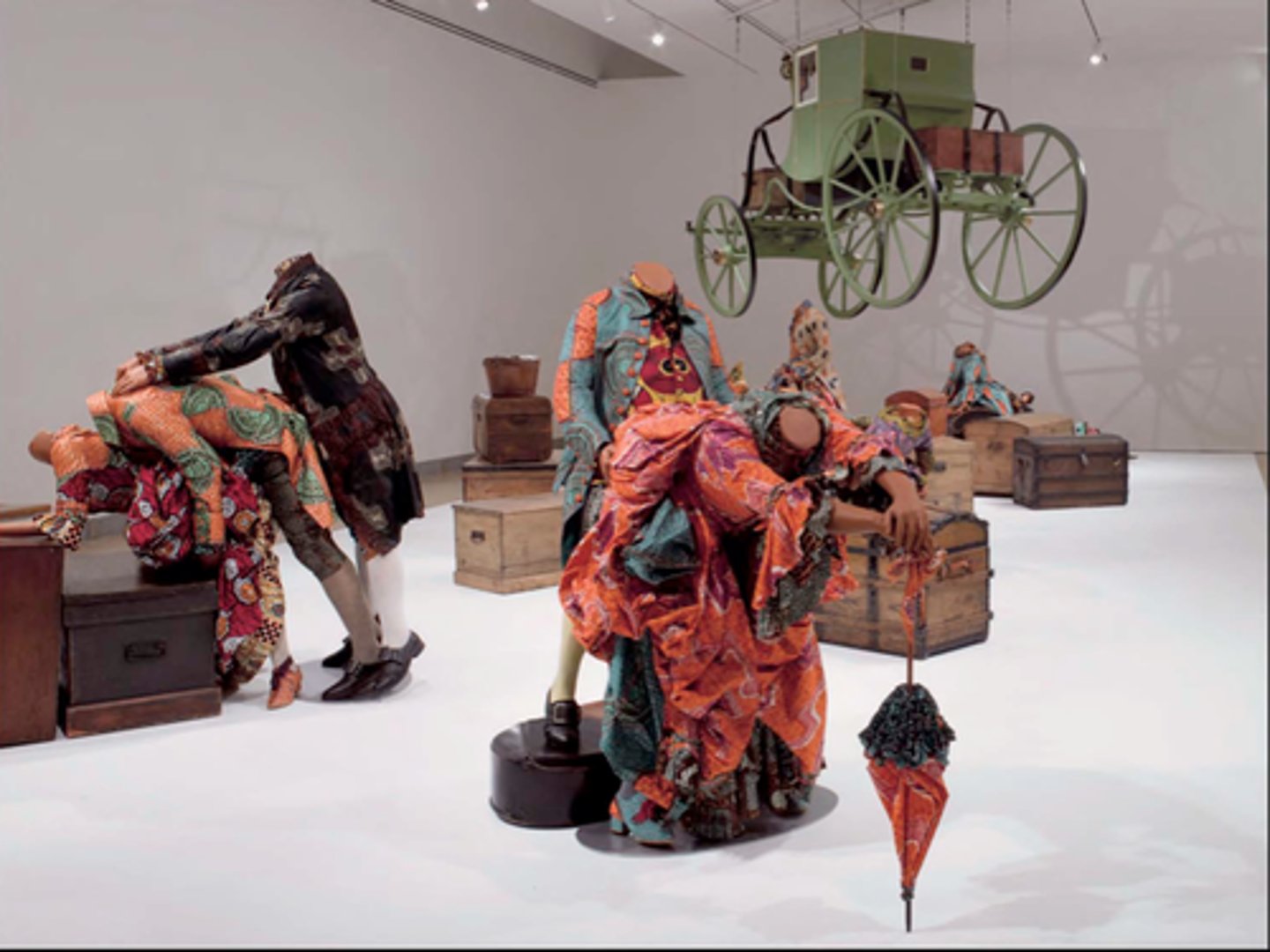
![<p>El <strong>An-a-tsu-i</strong> [Ghana]</p>](https://knowt-user-attachments.s3.amazonaws.com/8dc84f96-4413-4972-9444-801accba3bc7.png)
El An-a-tsu-i [Ghana]
Title: Fresh and Fading Memories
Time: 2007.
Known for:
Sculptural tapestries from bottle caps
explores themes of memory, history, and cultural change, using the material of bottle caps to reflect on the impact of globalization and colonialism in African societies.
The installation suggests the passing of time and the impermanence of both personal and collective memory through its fluid, shifting forms.
The work can be interpreted as a metaphor for the evolving nature of history—how memories may be distorted or faded over time.
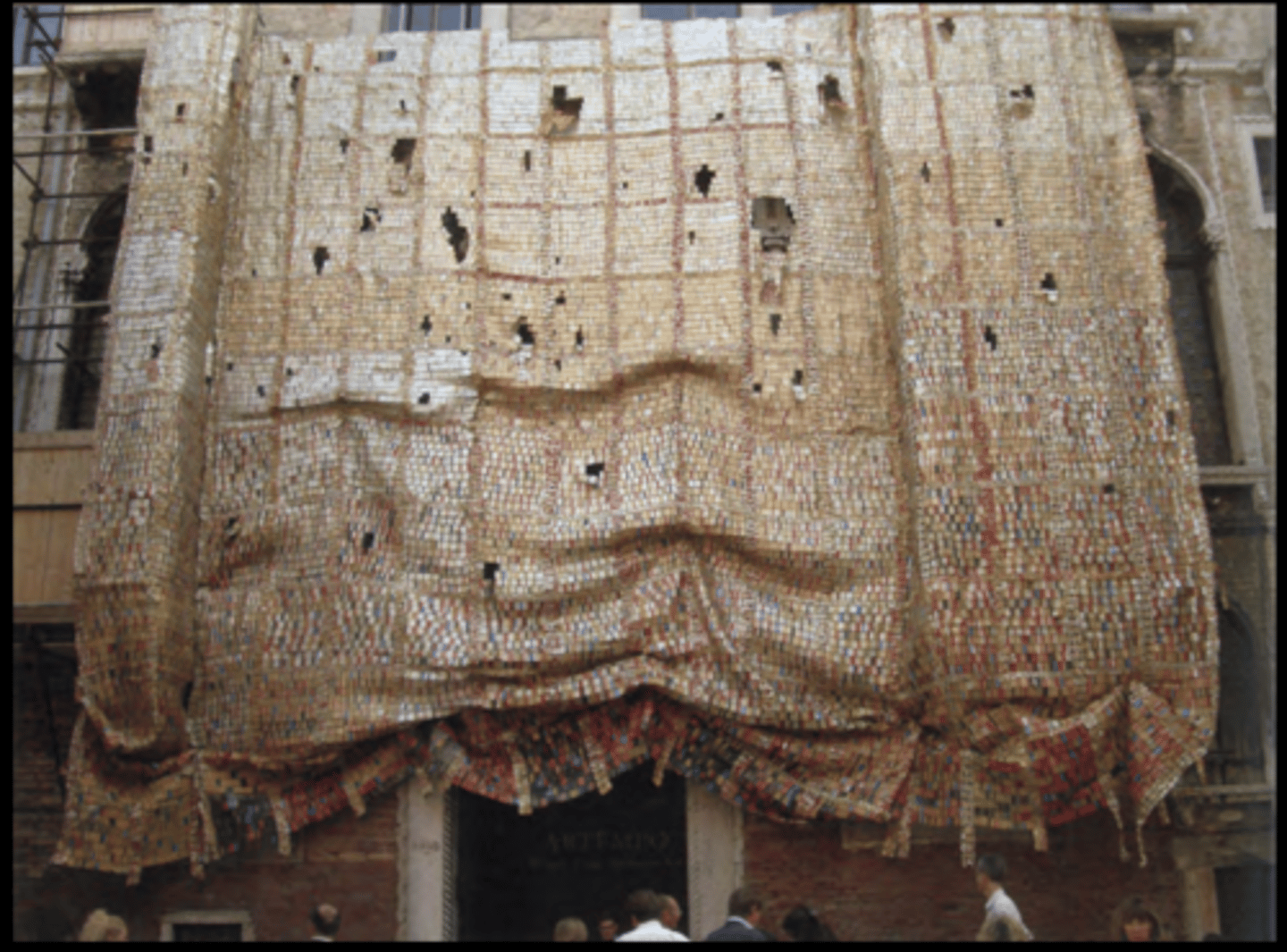
![<p><strong>Jane Alexander</strong> [South Africa]</p>](https://knowt-user-attachments.s3.amazonaws.com/fe6c7c78-70f0-4ba7-8822-cc95603f3fd6.png)
Jane Alexander [South Africa]
Title: The Butcher Boys
Time: 1980s.
Known for:
Created during apartheid-era South Africa, the work is a haunting allegory for the brutality, dehumanization, and violence of the regime.
Part-human, part-beast, symbolizing the loss of empathy and moral corruption in a society governed by oppression and systemic racism.

![<p>Sue <strong>William-son</strong> [South Africa]</p>](https://knowt-user-attachments.s3.amazonaws.com/04646a23-31a9-495d-ac66-71c207f021a5.png)
Sue William-son [South Africa]
Title: Messages from the Moat
Time: 1997.
Known for:
Memorializes slave history via bottle installations.
The moat symbolizes barriers, separation, and containment, while the reflections in the water evoke the fragility of memory and identity.
Part of her broader artistic practice focused on memory, truth, and reconciliation, especially in the context of South Africa’s colonial and apartheid past.
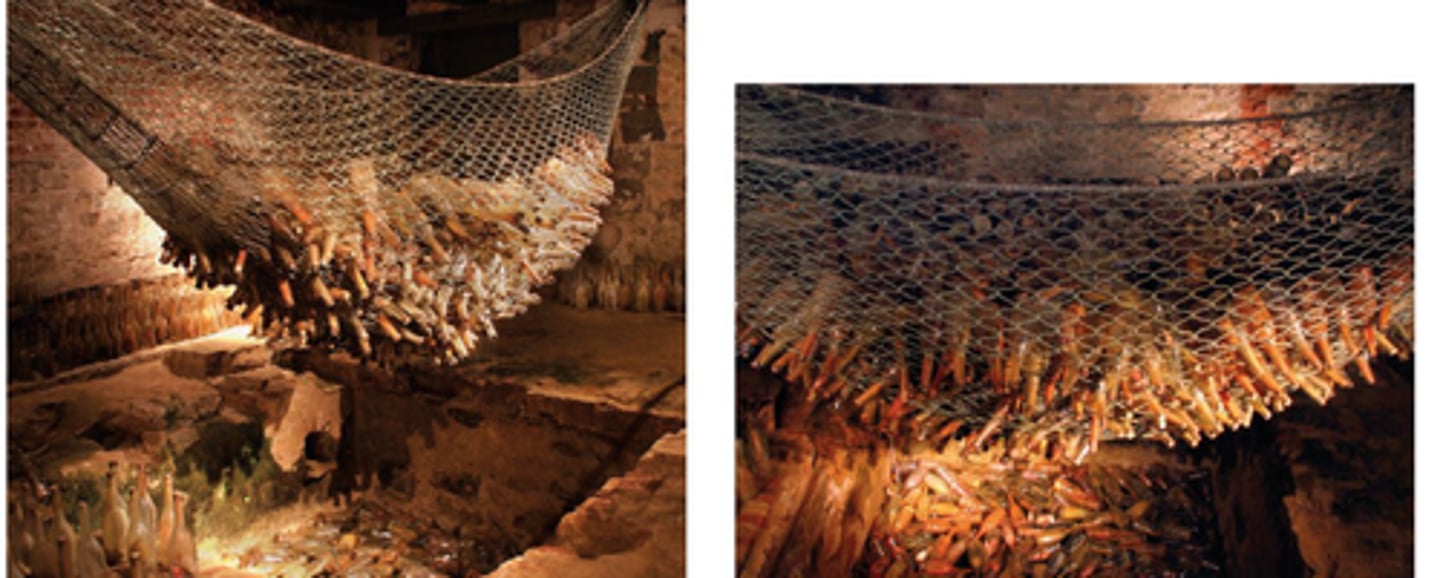
![<p>Wandjuk <strong>Ma-rika</strong> [Australia]</p>](https://knowt-user-attachments.s3.amazonaws.com/84b2f27f-9c7b-4f77-adb9-3688e3c34884.png)
Wandjuk Ma-rika [Australia]
Title: The Birth of the Djang'kawu Children at Ye-lang-bara
Time: 1980s.
Known for:
Bark painting using Rrark technique (cross hatching) to convey ancestral stories.
The painting asserts Aboriginal sovereignty and connection to land, challenging colonial narratives and emphasizing the deep continuity of Yolŋu law, identity, and spirituality.
was a pioneer in bringing Aboriginal art and voice into national and international recognition, combining traditional methods with a commitment to cultural and political advocacy.
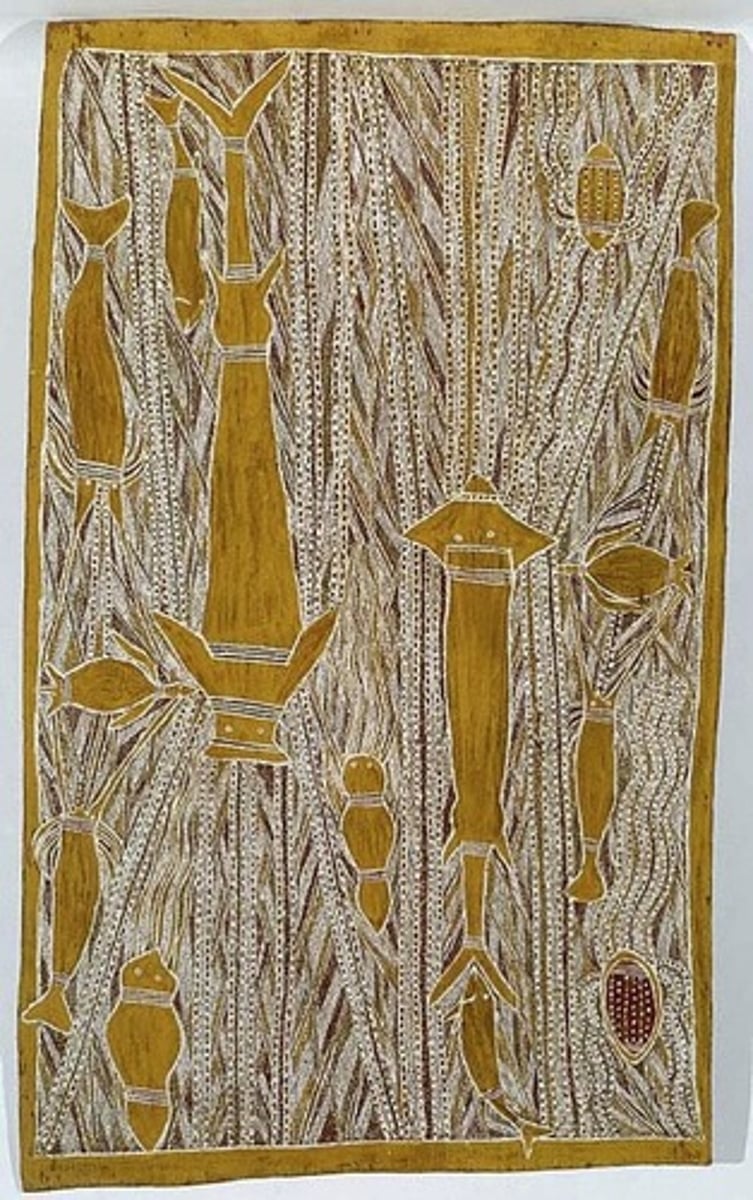
![<p><strong>Uta Uta</strong> Tjangala [Australia]</p>](https://knowt-user-attachments.s3.amazonaws.com/e66b5ba2-1d2c-48ff-bc41-ff7717fdb466.png)
Uta Uta Tjangala [Australia]
Title: Yumari
Time: 1980s.
Known for:
Anchored around the aboriginal culture.
Abstract desert scenes; coded storytelling via sacred symbols.
The work preserves and transmits sacred cultural knowledge, linking people, land, and law across generations.
Bold, rhythmic patterns and its role in reasserting Aboriginal identity and land rights through visual storytelling.

![<p>Richard <strong>Bell</strong> [Australia]</p>](https://knowt-user-attachments.s3.amazonaws.com/82e3d9d6-ea35-4292-8cf6-92897f124515.png)
Richard Bell [Australia]
Title: Scientia E Metaphysica [Bell's Theorem]
Time: 2003.
Known for:
Text-based critiques of the Western art market’s treatment of Aboriginal art.
Integrating floating lines overlapped onto serves of rectangular shapes of lines that are colorful and follow different orientations
The title plays on Bell’s Theorem (a term borrowed from quantum physics) to critique the cultural and political entanglement of Aboriginal art within white-dominated art markets and colonial power structures.
![<p>Title: Scientia E Metaphysica [<strong>Bell's Theorem</strong>]</p><p>Time: 2003.</p><p>Known for:</p><ul><li><p>Text-based critiques of the <strong>Western art market’s treatment of Aboriginal art</strong>.</p></li><li><p>Integrating floating lines overlapped onto serves of rectangular shapes of lines that are colorful and follow different orientations</p></li><li><p>The title plays on <strong>Bell’s Theorem</strong> (a term borrowed from quantum physics) to critique the <strong>cultural and political entanglement</strong> of Aboriginal art within <strong>white-dominated art markets</strong> and <strong>colonial power structures</strong>.</p></li></ul><p></p>](https://knowt-user-attachments.s3.amazonaws.com/d26bfdcd-8a32-492c-8ad7-b89b2184b1bb.jpg)
![<p><strong>Chen Z-hen</strong> [China]</p>](https://knowt-user-attachments.s3.amazonaws.com/1d6df3d7-eed2-421f-9ec6-79d9a28716ff.png)
Chen Z-hen [China]
Title: The Voice of Migrators
Time: 1990s.
Known for:
Multi-voice sculptures; Vibrant colors -> murmuring sounds
Highlights the psychological and emotional toll of migration, giving physical form to the silent stories of those caught between nations and identities.
The piece emphasizes communication and disconnection, illustrating how migrants’ voices are often unheard or misunderstood in dominant cultures.
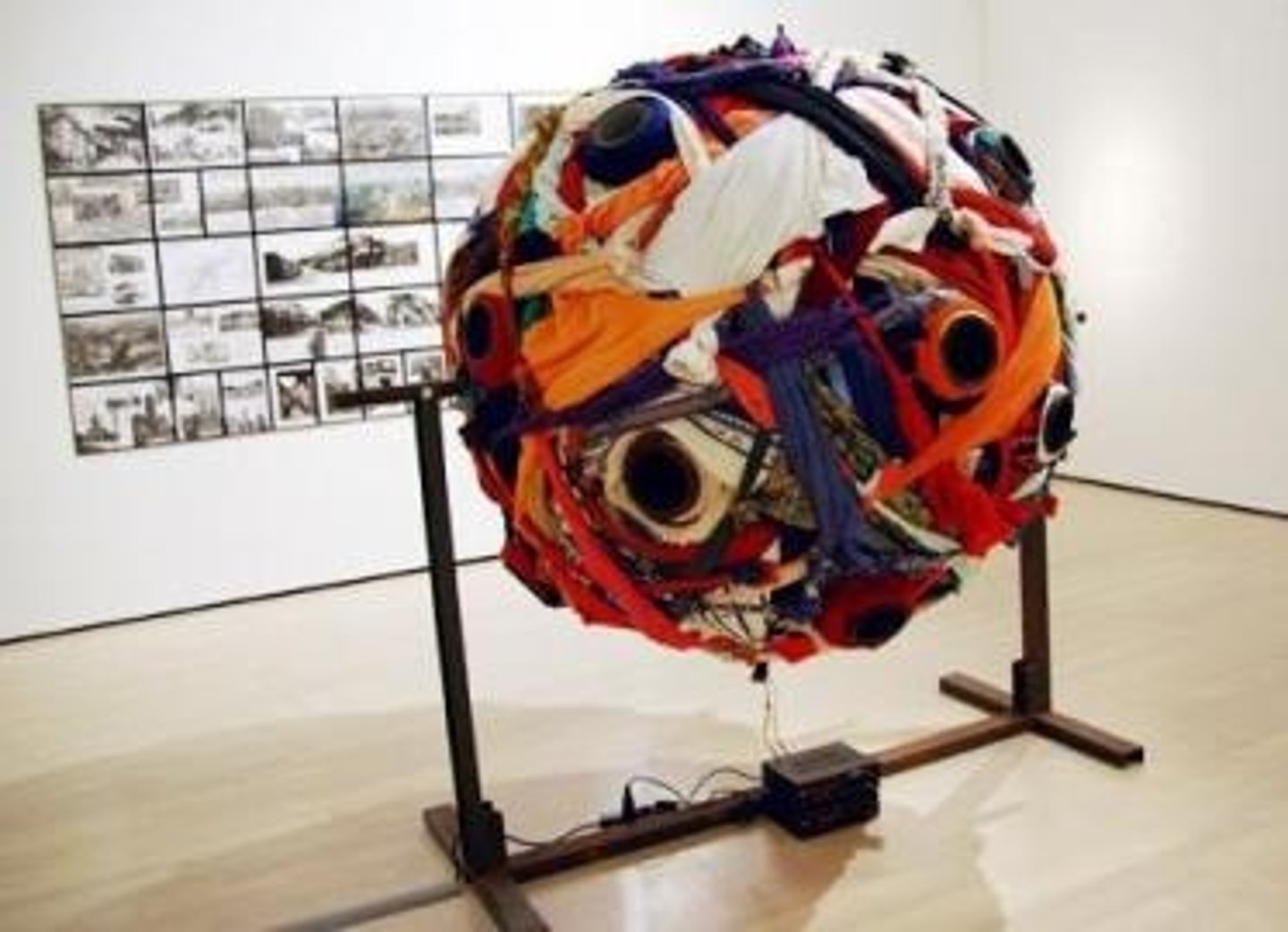
![<p>Mark <strong>Lom-bardi</strong> [United States]</p>](https://knowt-user-attachments.s3.amazonaws.com/ada13378-d1e7-4be1-bc30-aafd18f56e02.png)
Mark Lom-bardi [United States]
Title: World Finance Corporation and Associates
Time: 1970s-1980s.
Known for:
A diagrammatic drawing mapping out complex global financial and political scandals, including connections between banks, corporations, political figures, and criminal networks.
His work is celebrated for exposing hidden power structures and the interconnectedness of global corruption, often predicting patterns that were only later publicly acknowledged.
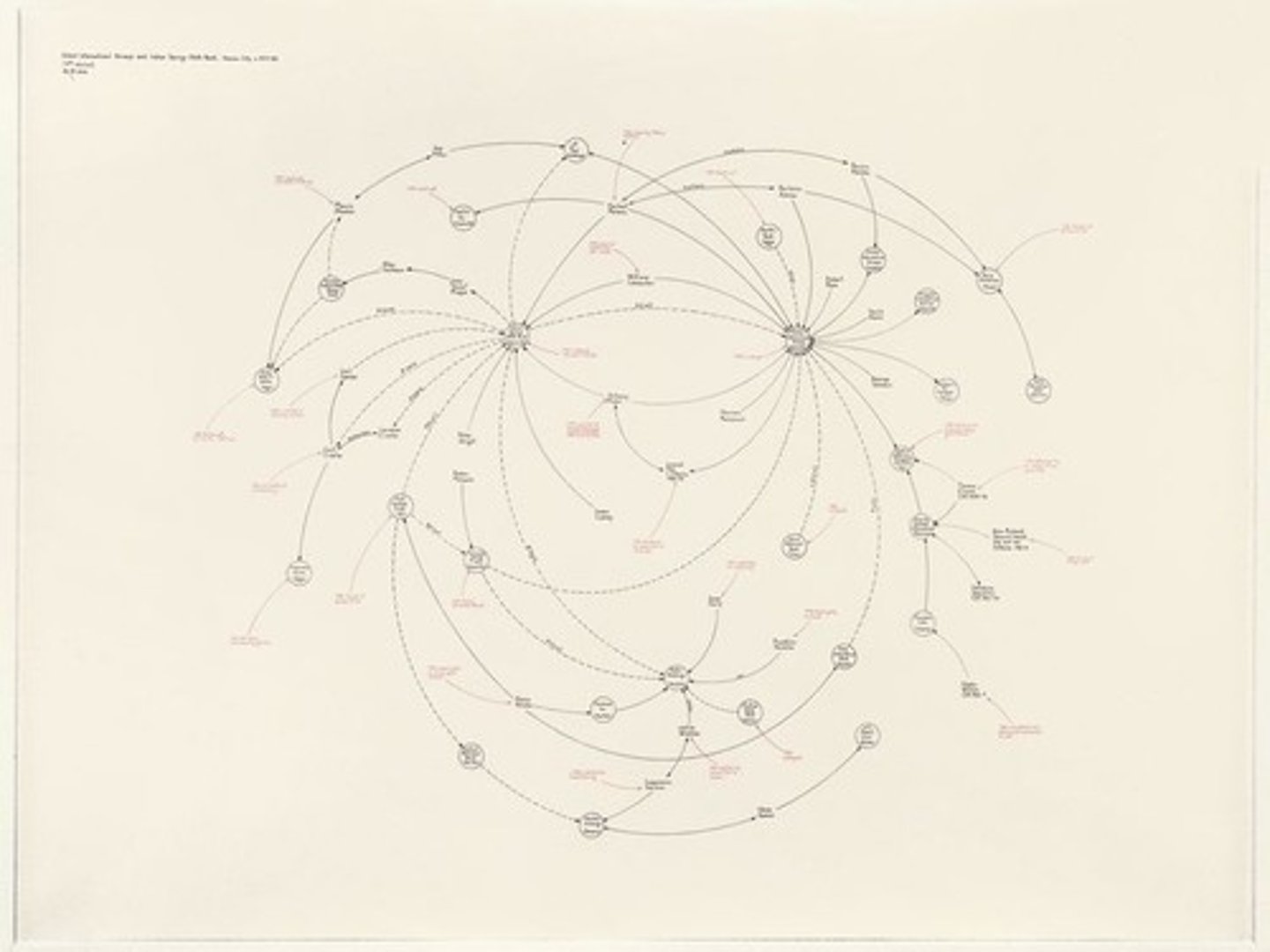
![<p>Thomas <strong>Hir-sch-horn</strong> [Switzerland/France]</p>](https://knowt-user-attachments.s3.amazonaws.com/064898b5-66b4-4847-acf7-f47741deec27.png)
Thomas Hir-sch-horn [Switzerland/France]
Title: Bataille Monument
Time: 2002.
Known for:
Named after philosopher Georges Bataille, the work explores themes of excess, power, community, and resistance.
Reflects their commitment to "presence and production", where art is inseparable from life, and emphasizes inclusion over exclusivity in the art world.
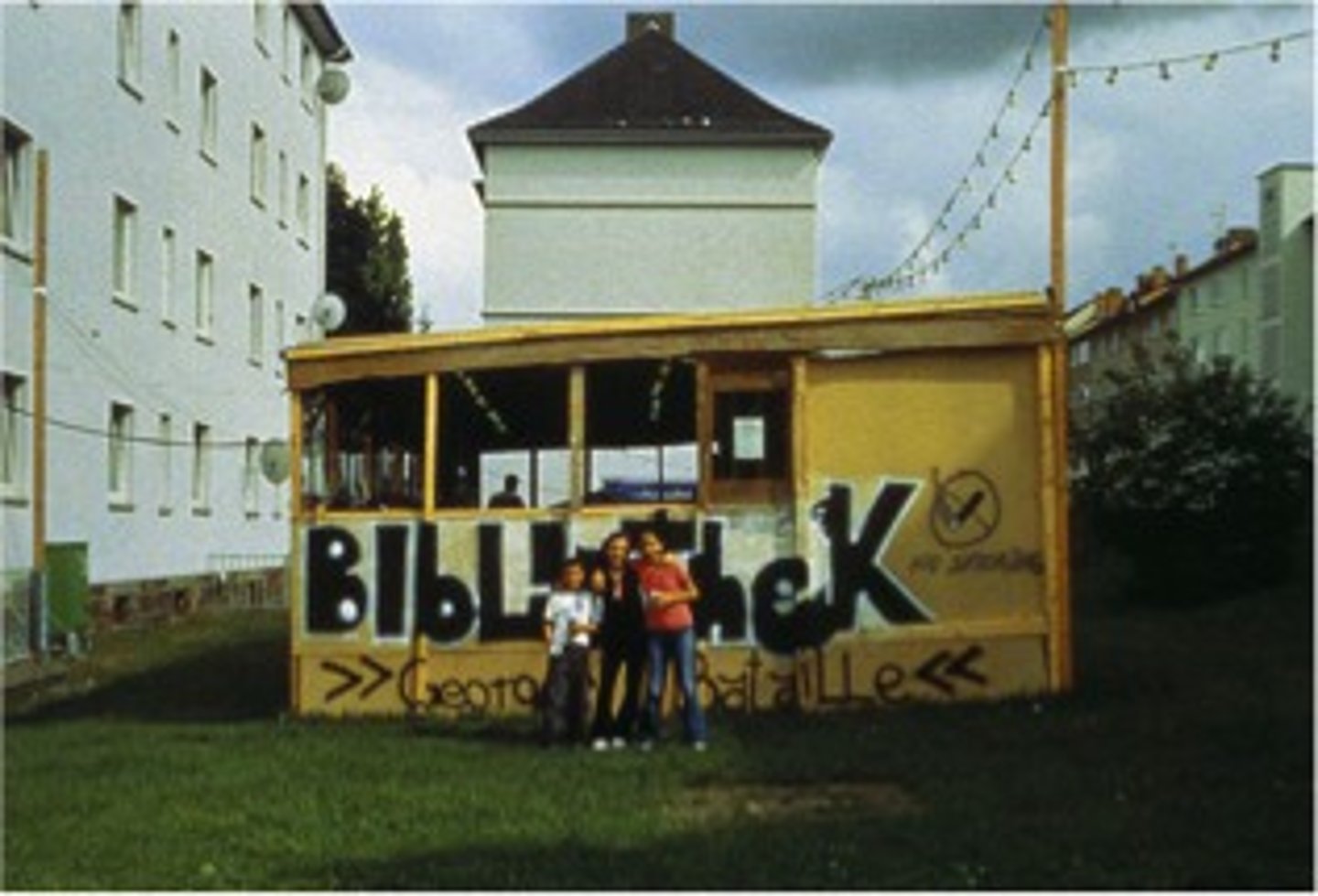
![<p>Ai <strong>Weiwei</strong> [China]</p>](https://knowt-user-attachments.s3.amazonaws.com/e6e063c0-525d-44ec-aeee-ec6907de4279.png)
Ai Weiwei [China]
Title: World Map
Time: 2006.
Known for:
A large-scale map of the world made entirely from pieces of tattered leather, hand-stitched together and laid flat on the floor.
Symbolizes the fragmentation and artificial construction of national boundaries, questioning the meaning of global unity in the face of conflict, inequality, and migration.
Reflects their broader concerns with freedom, human rights, and geopolitical power structures, especially in relation to China’s position in the world.
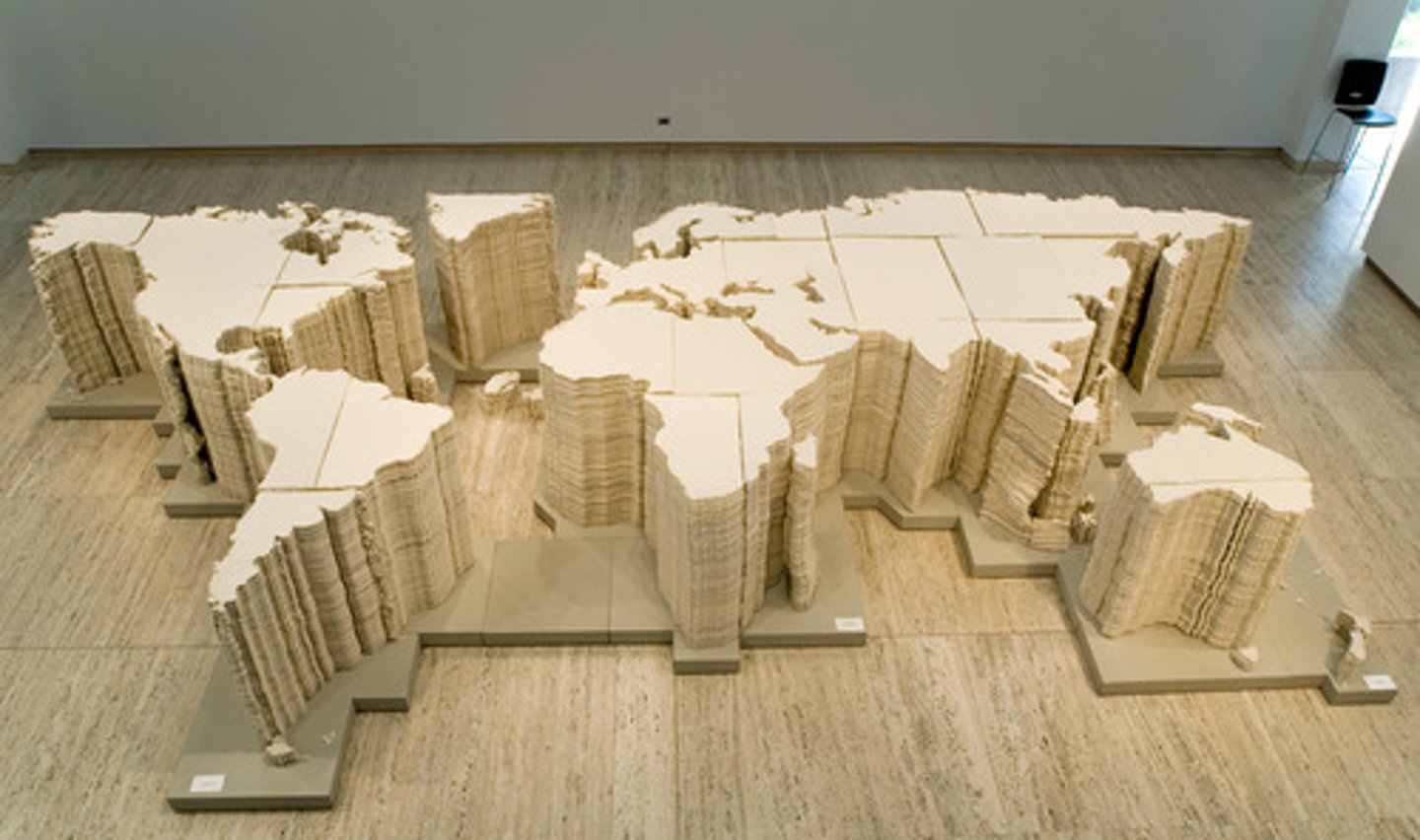
![<p>James <strong>Turrell</strong> [United States]</p>](https://knowt-user-attachments.s3.amazonaws.com/51de3b51-72a3-4a20-8786-9399d2027f13.png)
James Turrell [United States]
Title: Roden Crater
Time: Since 1970s.
Known for:
A site-specific, monumental earthwork located in an extinct volcanic crater in northern Arizona, Roden Crater is designed as an immersive, spiritual, and sensory experience that engages with light, space, and the sky.
The project aims to alter perception by manipulating natural and artificial light to create a meditative, almost transcendental environment where visitors experience visual phenomena, such as color shifts and changing atmospheres.
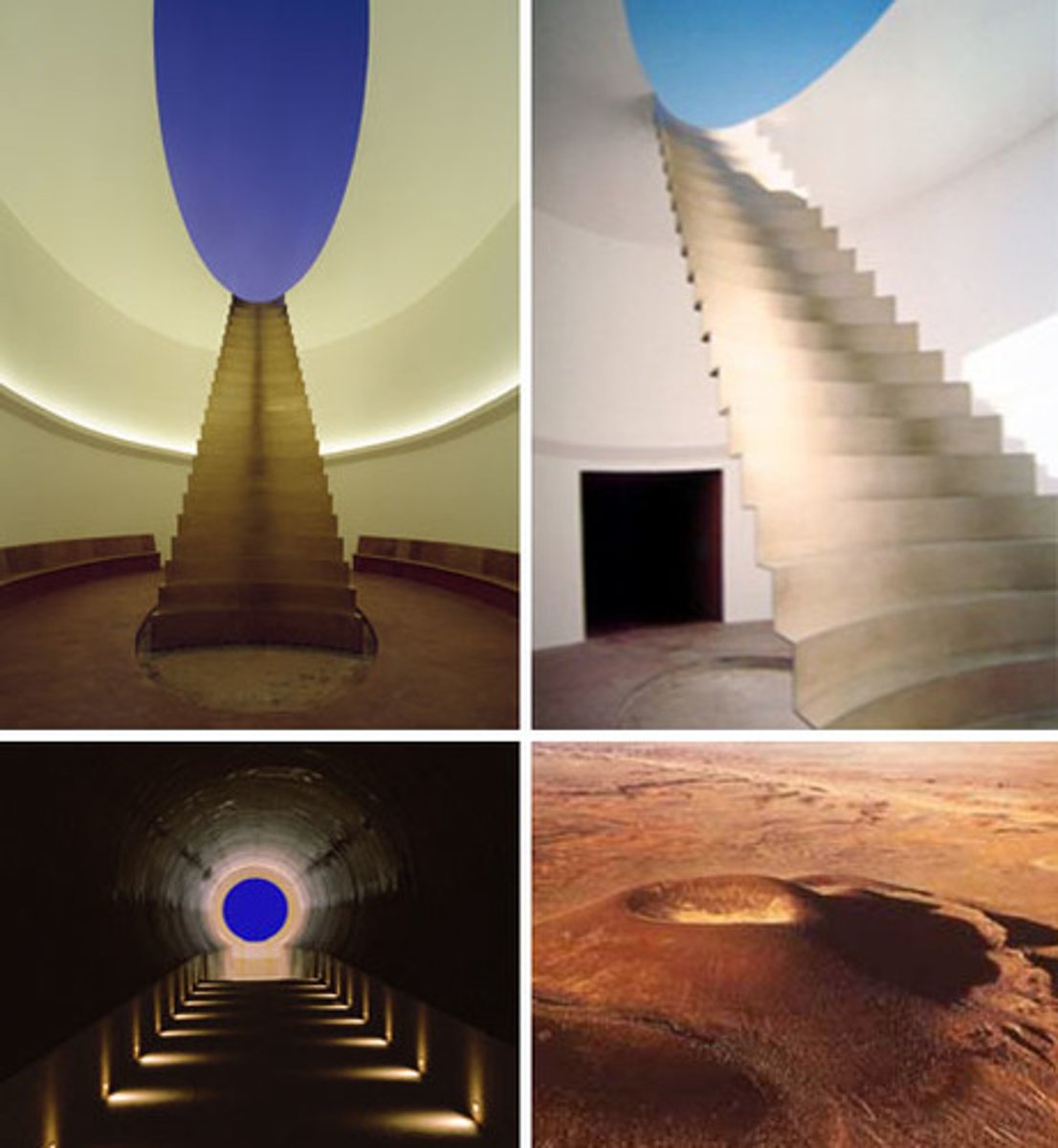
![<p>Agnes <strong>De-nes</strong> [Hungary/United States]</p>](https://knowt-user-attachments.s3.amazonaws.com/d9227362-0bc7-405b-95c6-f758c2d143e3.png)
Agnes De-nes [Hungary/United States]
Title: Wheatfield - A Confrontation
Time: 1980s.
Known for:
Wheat field in Manhattan
The work symbolizes the relationship between nature, urbanization, and human intervention, drawing attention to the fragility of the environment in the face of modern industrial and technological development.
Serves as a critique of consumerism, industrialization, and the disconnect between natural resources and urban society.
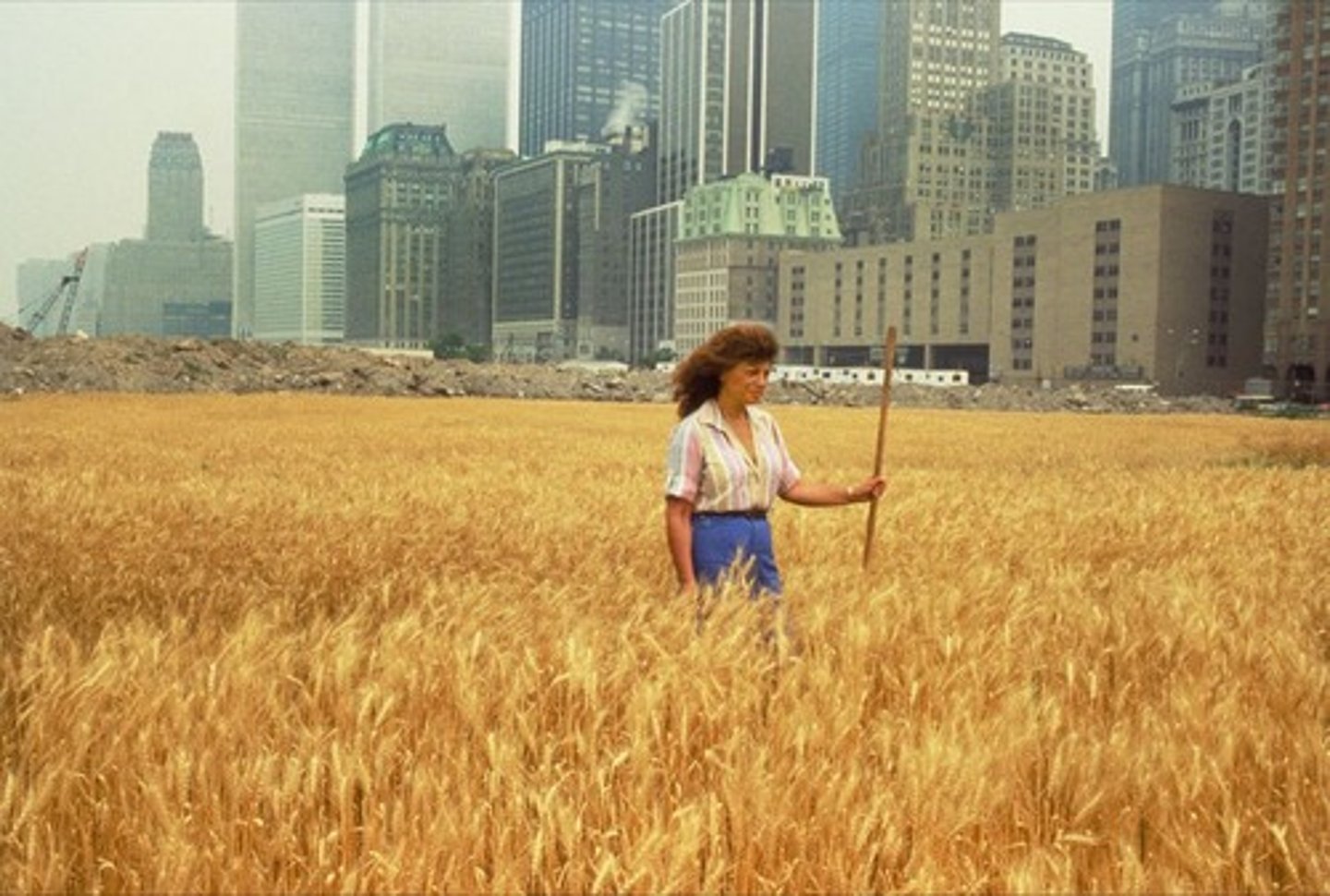
![<p><strong>Joseph Beuys </strong>[Germany]</p>](https://knowt-user-attachments.s3.amazonaws.com/99536022-70c0-4438-9874-13776c703171.png)
Joseph Beuys [Germany]
Title: 7000 Oaks
Time: 1980s.
Known for:
A land art and environmental project that involved planting 7000 oak trees, each tree was accompanied by a stone column, symbolizing the idea of growth, regeneration, and human responsibility toward the environment.
Nature and culture must coexist in harmony.
The trees, growing over time, represent renewal and hope for the future, underscoring Beuys' commitment to ecology, community, and the intersection of art and social change.

![<p>Andy <strong>Golds-worthy</strong> [UK]</p>](https://knowt-user-attachments.s3.amazonaws.com/7167cacd-af2f-46a8-a89c-49a5823adf6a.png)
Andy Golds-worthy [UK]
Title: Reconstructed icicles/around a tree/finished late afternoon/catching the sunlight/Glen Martin Falls
Time: 1990s.
Known for:
celebrating the natural world while acknowledging the fragility of both the materials and the natural environment itself.
It also explores themes of human intervention in nature and the relationship between art and the environment.

![<p>Gordon <strong>Matta-Clark</strong> [USA]</p>](https://knowt-user-attachments.s3.amazonaws.com/40cafd00-ef8c-44cc-aa7f-58ab9d5b77b2.png)
Gordon Matta-Clark [USA]
Title: Reality Properties: Fake Estates
Time: 1974.
Known for:
A conceptual art project in which they purchased small, often useless, overlooked properties in New York City, including narrow strips of land between buildings or abandoned spaces, which he dubbed “Fake Estates.”
The project critiques the commodification of land and the artificial nature of property value, using land as both a material and a concept to challenge traditional ideas of ownership, urban development, and space.

![<p><strong>Ol-a-fur</strong> Eliasson [Denmark/Iceland/Germany]</p>](https://knowt-user-attachments.s3.amazonaws.com/7e7d063b-3f9e-49a1-8404-5e5f9aa2c305.png)
Ol-a-fur Eliasson [Denmark/Iceland/Germany]
Title: The Weather Project
Time: 2003-4.
Known for:
A large-scale immersive installation exhibited in the Turbine Hall of the Tate Modern in London, which featured a massive artificial sun made of monitors and mirrors. The work simulated a weather phenomenon and created a surreal environment that allowed visitors to engage with the perception of natural elements.
The Weather Project is known for blurring the lines between art and environmental experience, as it created a space where visitors could reflect on the relationship between nature, technology, and human perception.
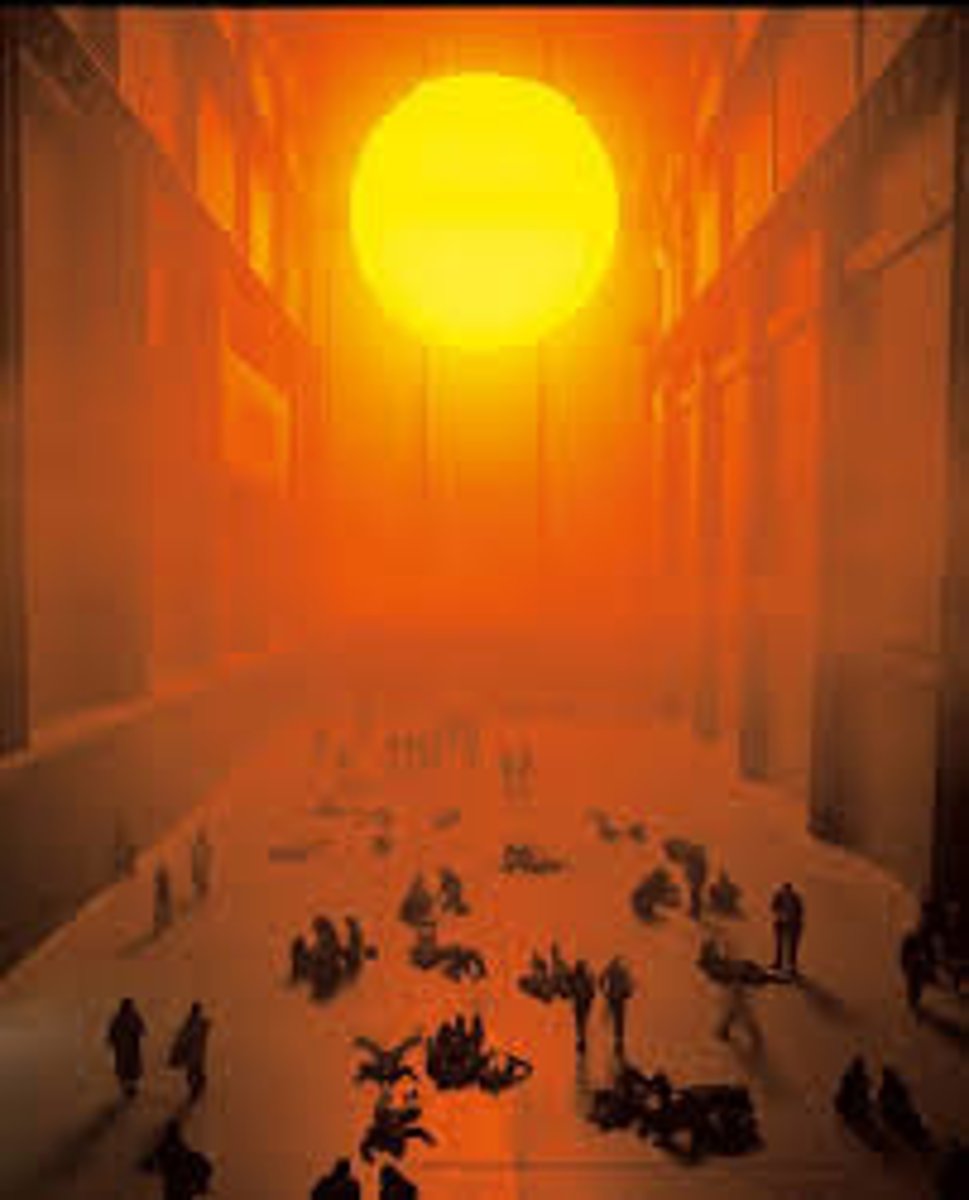
![<p>Michael <strong>Ra-ko-witz </strong>[Iraq/USA]</p>](https://knowt-user-attachments.s3.amazonaws.com/0020bcf8-eef6-43e7-a1d0-eb0af71bfe98.png)
Michael Ra-ko-witz [Iraq/USA]
Title: paraSITE Shelter for Michael McGee
Time: 2000.
Known for:
Custom shelters for homeless people
Empathy meets design; using inflatable materials - vinyl, nylon
Known for his socially conscious art, Rakowitz's work critiques inequality, homelessness, and the failure of urban systems to address the needs of vulnerable populations. It also challenges the idea of architecture as a tool for exclusion, showing how art can provide immediate, practical solutions to real-world issues.

![<p>Jennifer <strong>Allora</strong> [USA] and <strong>Guillermo</strong> Calzadilla [Cuba]</p>](https://knowt-user-attachments.s3.amazonaws.com/928042be-03b4-4613-9ada-8032c486da05.png)
Jennifer Allora [USA] and Guillermo Calzadilla [Cuba]
Title: Land Mark Footprints
Time: 2001-2.
Known for:
The work took place on an island near Cuba, once home to an American military base that conducted weapon experiments, devastating the land. The island's people were protesting the military presence.
A performance-based installation that involved footprints being left in the sand by the artists' use of footwear designed as large, sculptural casts. These footprints were intended to serve as a symbolic mark on the land, questioning the impact of individual and collective actions on the environment and history.
The project raises questions about ownership of land, national borders, and the legacy of historical movements, with the footprints serving as metaphors for larger geopolitical movements like imperialism and cultural displacement.

![<p><strong>Rir-k-rit</strong> Tiravanija [Thailand]</p>](https://knowt-user-attachments.s3.amazonaws.com/86a58e2c-1ffa-4b46-8b82-cb93459dac65.png)
Rir-k-rit Tiravanija [Thailand]
Title: Untitled Free
Time: 1990s.
Known for:
A conceptual art piece where they transformed a gallery space into a kitchen and served free food to visitors, creating a communal experience rather than a traditional artwork.
The piece is centered around the idea of interaction, hospitality, and the social aspect of art. The act of cooking and sharing food invited viewers to become active participants, breaking down the typical boundary between artist and audience.
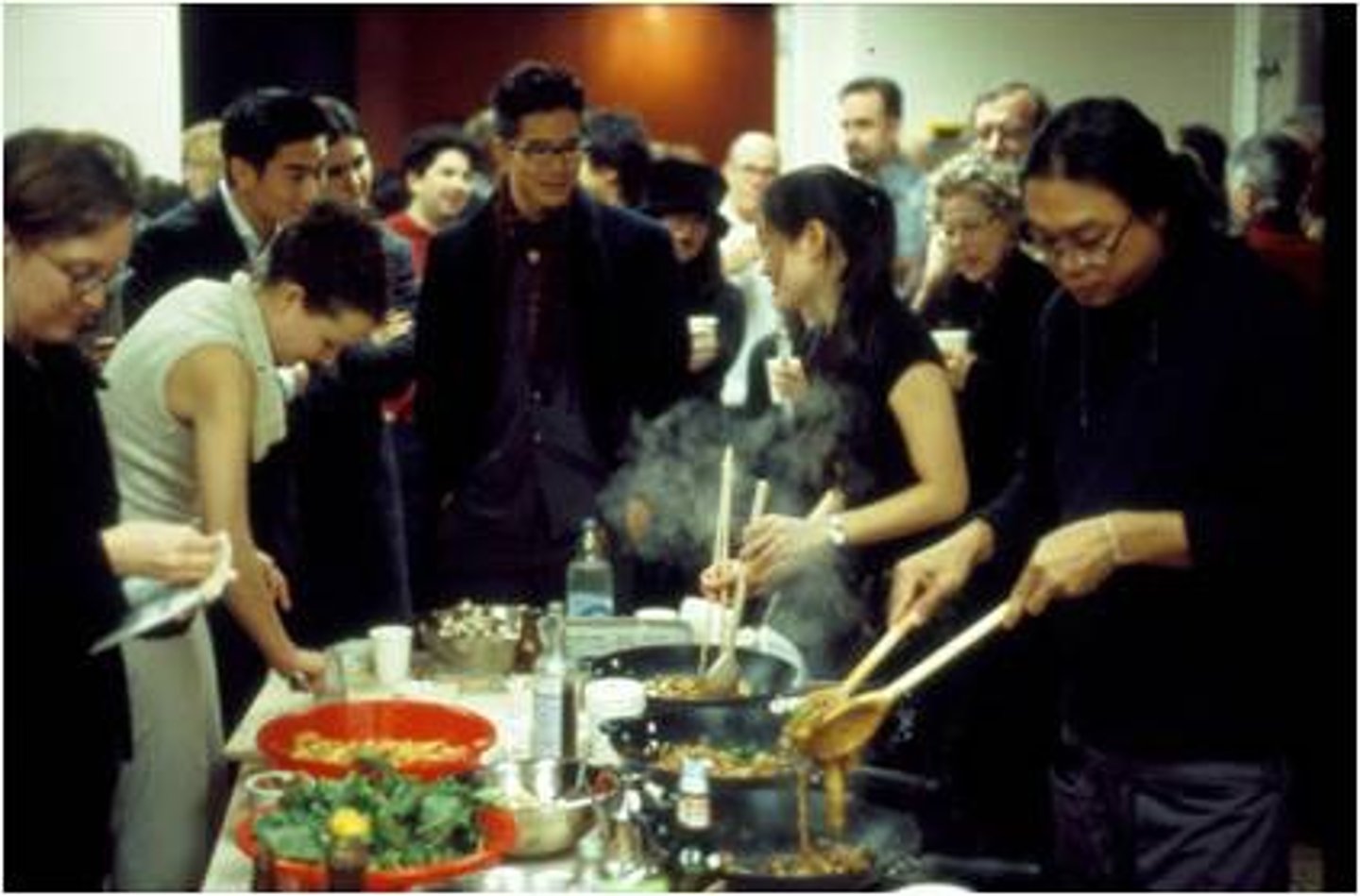
![<p>Andrea <strong>Zittel</strong> [USA]</p>](https://knowt-user-attachments.s3.amazonaws.com/ca5c9d5e-74b4-4f76-8e7f-3ee2c87a6958.png)
Andrea Zittel [USA]
Title: A - Z Cellular Compartment Units
Time: 2001.
Known for:
A series of modular, self-contained living units designed to challenge ideas about personal space, comfort, and individual autonomy. Each unit, which could be used as a miniature living space, was designed with functional compartments for different activities like sleeping, eating, and working.
Known for exploring alternative living arrangements and social systems, Zittel's work critiques modern consumerism and the societal pressure to accumulate material goods and personal possessions.

![<p>Christian <strong>Nold</strong> [UK]</p>](https://knowt-user-attachments.s3.amazonaws.com/0592c405-0285-4b41-b402-5efc3ba2b7c4.png)
Christian Nold [UK]
Title: Biomapping/Emotion Mapping
Time: 2004 - ongoing.
Known for:
A participatory art project that uses biofeedback technology to create maps of emotional responses to specific locations. Participants wear sensors that track their physiological reactions (e.g., heart rate, skin conductivity) as they move through urban environments.
Their work blends art, technology, and psychology to explore the intersection of public spaces and individual emotions, raising questions about how environments influence our well-being and how personal data can be used to understand urban experiences.
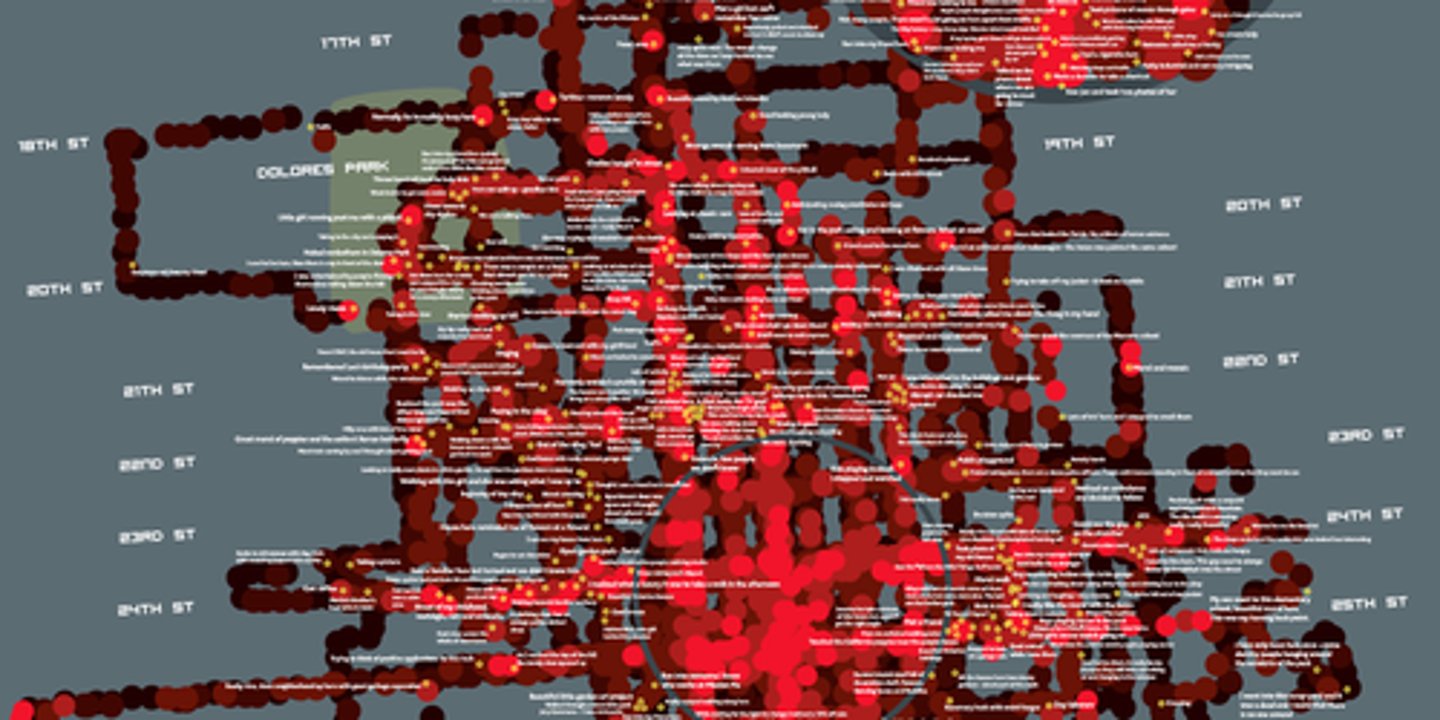
![<p><strong>Felix Gonzalez-Torres</strong> [Cuba/USA]</p>](https://knowt-user-attachments.s3.amazonaws.com/f243b110-71df-4066-9f80-6252f6e5ce30.png)
Felix Gonzalez-Torres [Cuba/USA]
Title: "Untitled" (Perfect Lovers)
Time: 1987-1990.
Known for:
Artist was inspired by grief after losing his partner to AIDS.
Clocks symbolizing love and loss; poetic minimalism.
The passage of time and the end of relationships
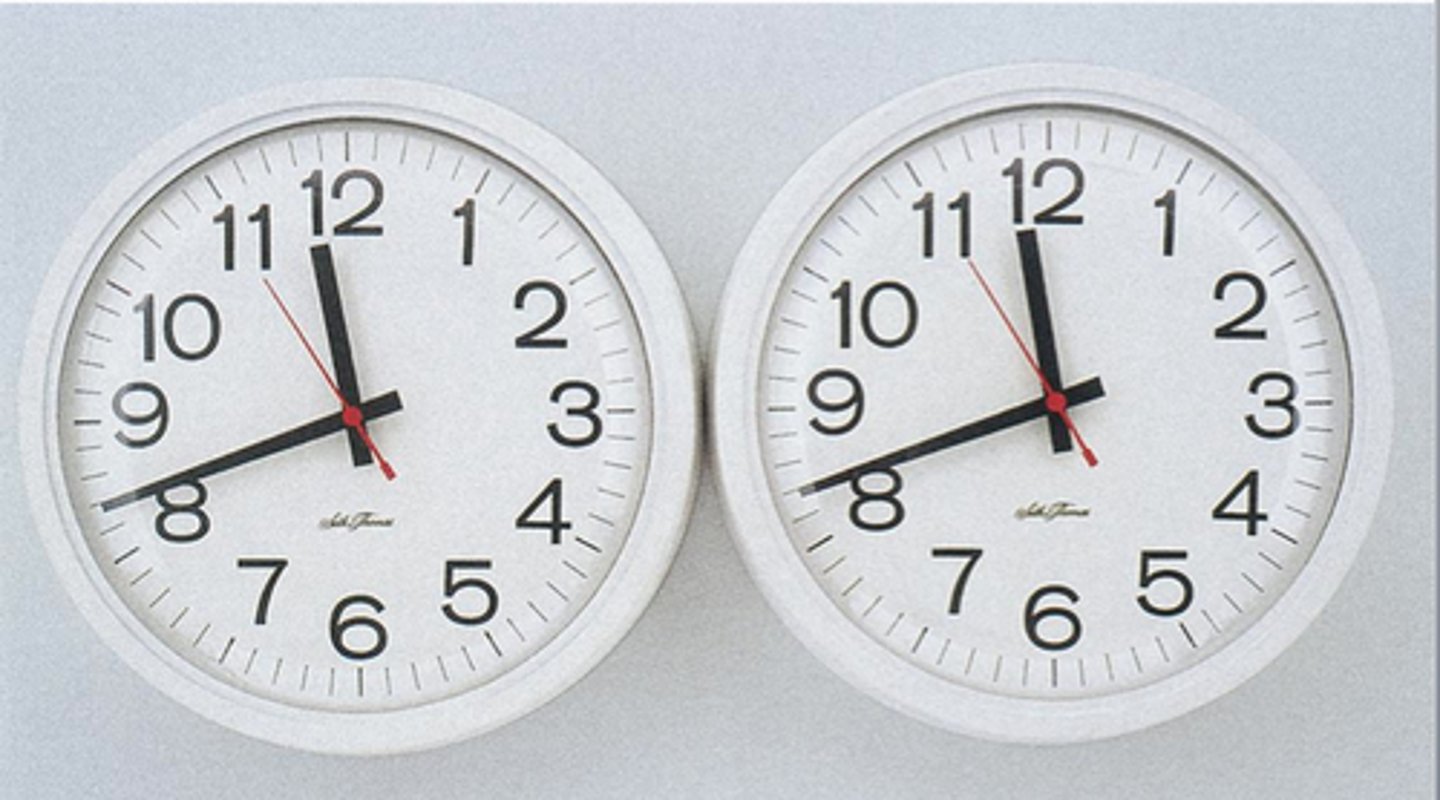
![<p><strong>Barbara Campbell</strong> [Australia]</p>](https://knowt-user-attachments.s3.amazonaws.com/edf6e78f-8b17-40c1-8d09-e4bd93c4f647.png)
Barbara Campbell [Australia]
Title: 1001 Nights Cast
Time: 2005-2008.
Known for:
Each night at sunset, she performed a short text-based work of the Arabian Nights as a live webcast. The performance texts were written for her each day in response to a prompt she drew from the morning's newspaper reports on the Middle East.
The work reflected on the connection between ancient and modern storytelling, emphasizing how stories from the past can still be relevant in addressing today’s political and social issues.
Each performance was a new interpretation, illustrating how the timeless nature of storytelling can offer insight into the ever-changing world.

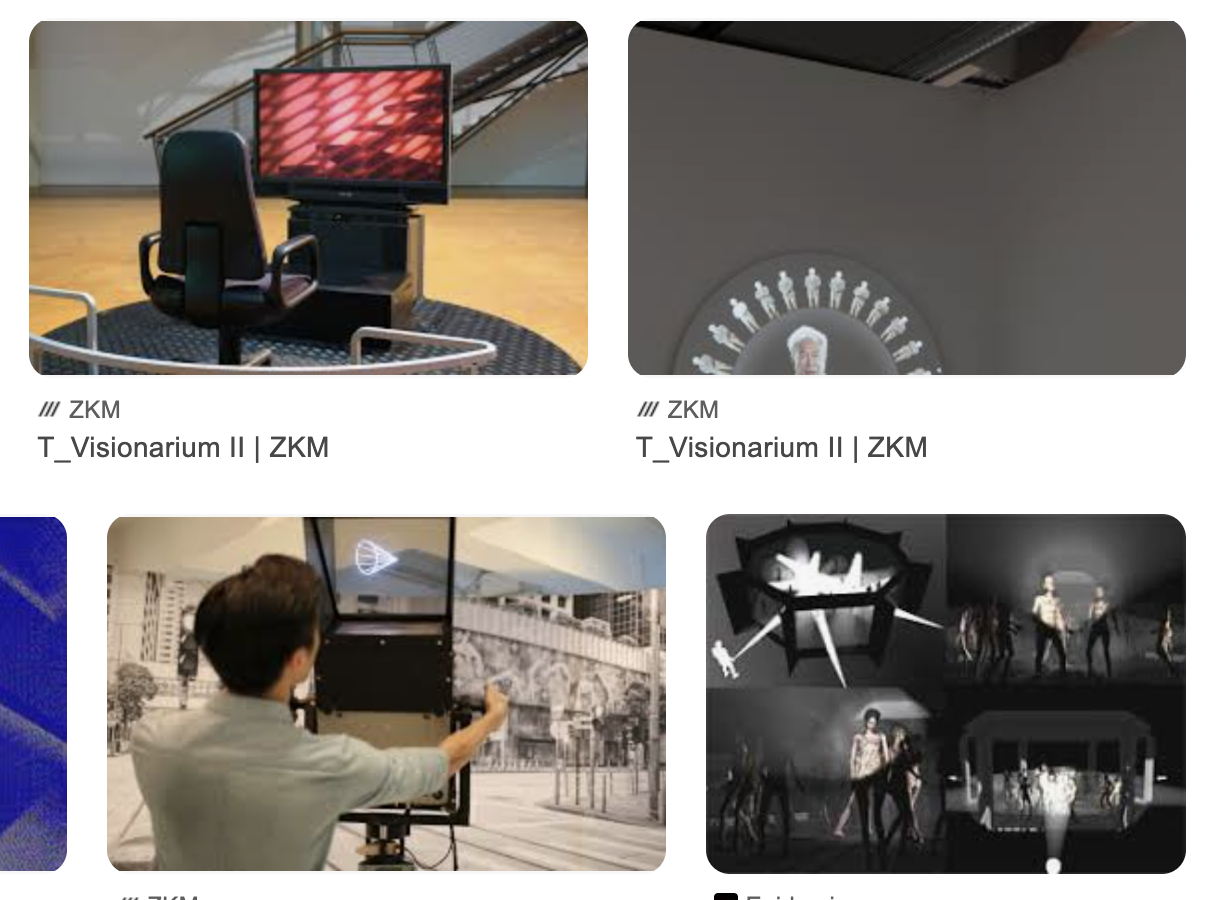
Neil Brown, Dennis Del Favero, Matt McGinity, Jeffrey Shaw, Peter Weibel
Title: T-Visionarium II
Time: 2008.
Known for:
T-Visionarium II is an immersive, interactive multimedia installation that combines virtual reality, interactive art, and real-time data to explore the relationship between vision, perception, and technology.
Explores the idea of hyperreality, where the boundaries between the real world and virtual spaces are increasingly blurred, and it raises questions about how technology can influence our sense of self, awareness, and perception of reality.

![<p>Rafael <strong>Lozano-Hemmer</strong> [Mexico/Canada]</p>](https://knowt-user-attachments.s3.amazonaws.com/aba04aa3-bc05-45f1-9d2d-51e903335cf4.png)
Rafael Lozano-Hemmer [Mexico/Canada]
Title: Under Scan
Time: 2005.
Known for:
Digital interactive public art project
Interactive projections, of locals who volunteered, appear in viewers’ shadows using motion-tracking.
Explores connection, surveillance, and spontaneous encounters in public space.
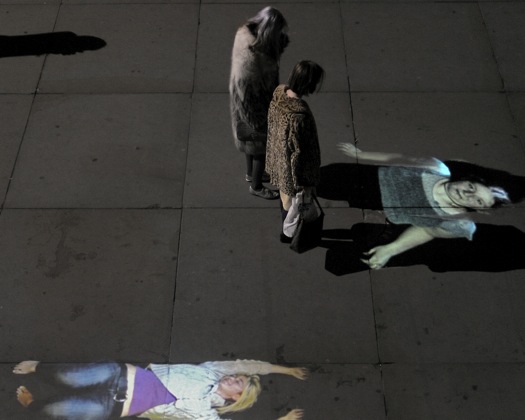
Tehching H-sieh and Linda Mon-tano
Title: Art/Life One Year Performance
Time: 1980s.
Known for:
A durational performance in which they spent one full year tied together by an 8-foot rope, without ever touching each other, and without spending a moment apart unless in emergencies.
It explores endurance, interpersonal boundaries, and the tension between connection and autonomy, questioning the limits of time, intimacy, and commitment as both artistic material and lived experience.
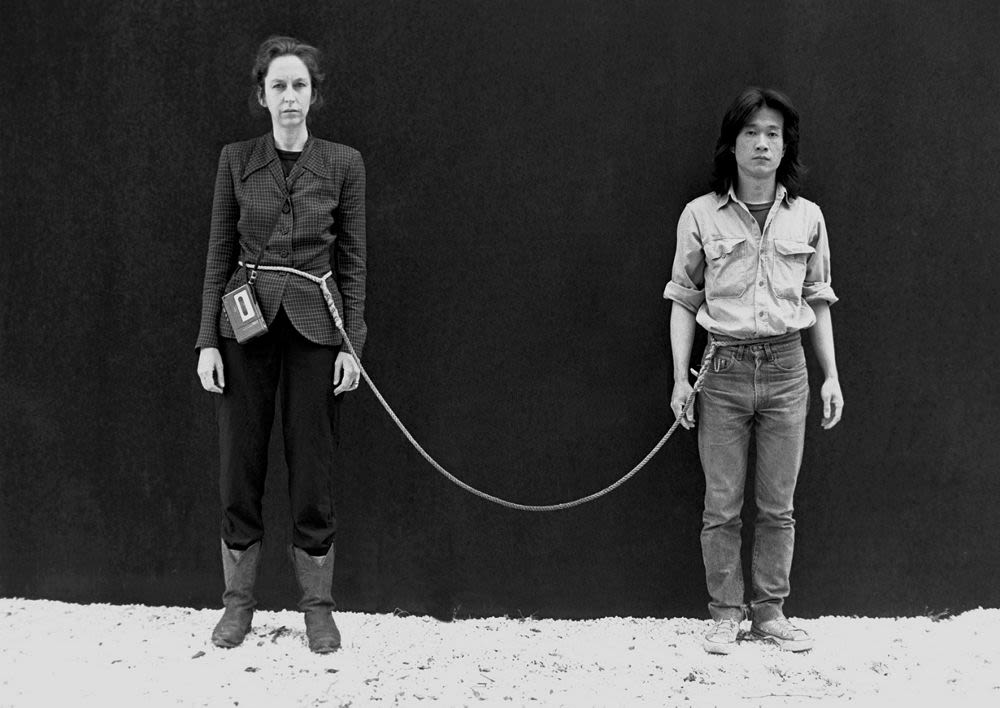

Jeremy Deller
Title: Reenactment of the Battle of Orgreave
Time: 2001
Known for:
The Battle of Orgreave is a large-scale reenactment of a violent clash between striking miners and police that originally took place in 1984 during the UK miners’ strike, involving over 800 participants, many of them actual miners and local residents.
It investigates the politics of memory, class struggle, and collective trauma, using historical reenactment as a form of social commentary.
Blurs the line between documentary, performance, and activism.

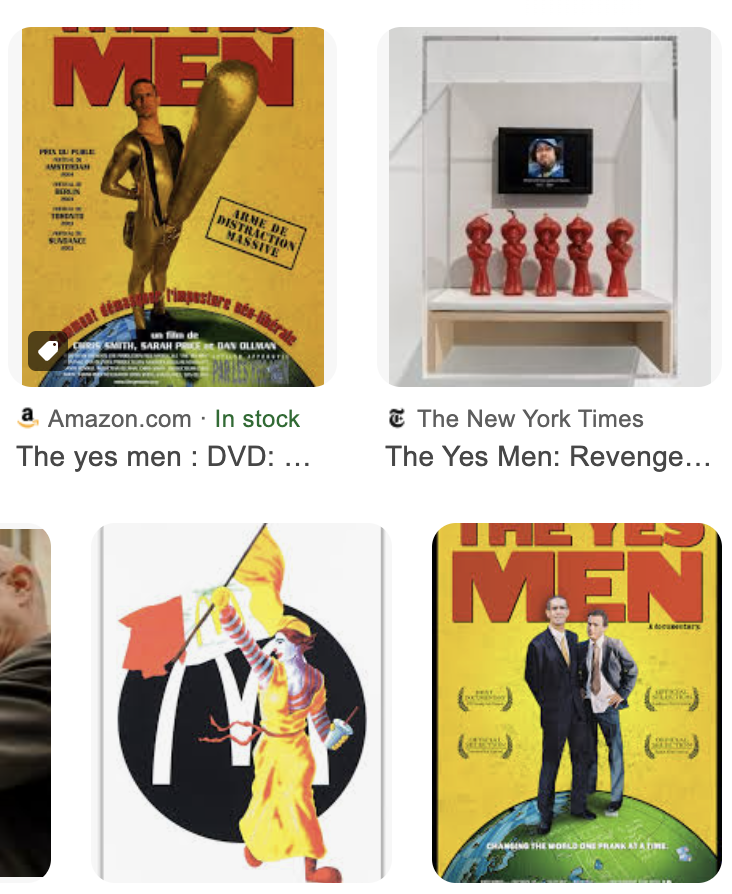
The Yes Men
Title: Bhopal Apology
Time: 2003
Known for:
Bhopal Apology is a high-profile media hoax in which one of the artists appeared on BBC World posing as a Dow Chemical spokesperson, falsely announcing that the company would finally take responsibility for the 1984 Bhopal disaster and compensate victims.
It critiques corporate negligence, media credibility, and the limits of corporate accountability
Uses satire and impersonation to expose the gap between public relations narratives and real-world consequences.


Christian Marclay
Title: The Clock
Time: 2010
Known for:
24-hour video montage composed of thousands of film clips showing clocks or references to time
Synchronizes with real time—viewers can literally “watch” time pass
Explores our perception of time, cinematic memory, and collective experience, blurring the line between narrative and reality by transforming timekeeping into both a functional tool and an immersive, meditative artwork.


Titus Kap-har
Title: Seeing through Time
Time: 2018.
Known for:
oil on canvas
Reimagines art history by replacing aristocratic white figures with powerful contemporary Black women
It challenges dominant historical representations by exposing the absence or distortion of Black figures in Western art, inviting viewers to reconsider whose stories are told, how they’re framed, and what lies beneath the surface of cultural memory.

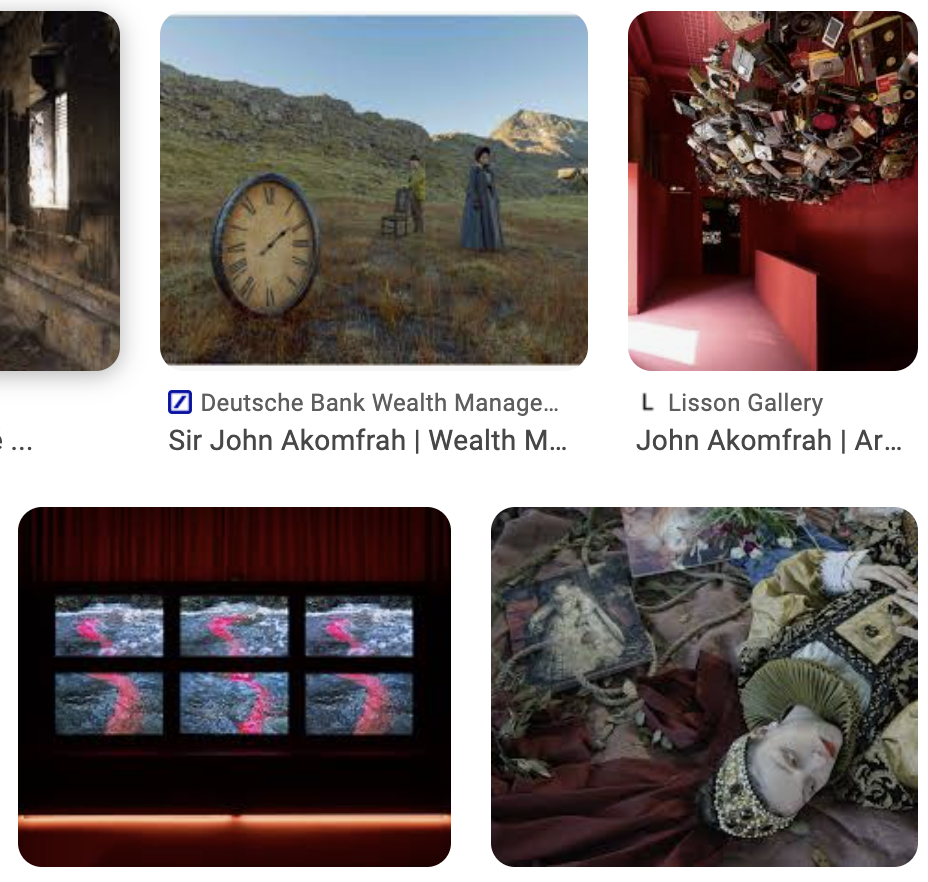
John A-kom-frah
Title: Vertigo Sea
Time: 2015
Known for:
Vertigo Sea is a three-channel video installation that weaves archival footage, staged scenes, and poetic narration to explore the ocean as a site of historical trauma, migration, slavery, and ecological crisis.
It reflects on the interconnectedness of human suffering and environmental degradation, using the sea as a metaphor for memory, loss, and the ongoing consequences of colonialism and exploitation.
